Aramark, AmeriPride Services to merge in billion-dollar deal

PHILADELPHIA —
Aramark, a provider of services in food, facilities management and uniforms based here, has entered into a definitive agreement to acquire AmeriPride Services, a textile rental and supply company based in Minnetonka, Minn., the company reports.
“AmeriPride is a highly respected company with a tremendous legacy that will extend and complement Aramark’s uniforms business,” says Eric J. Foss, Aramark’s chairman, president and CEO.
“This merger will enable us to enhance our customer service experience, unlock improved efficiencies, develop new career opportunities for employees and deliver value for our shareholders. Our companies share a commitment to world-class service, and I look forward to welcoming AmeriPride to the Aramark family.”
Aramark says it will acquire AmeriPride for a purchase price of $1.0 billion, or a net purchase price of $850 million after adjusting for the value of anticipated tax benefits. AmeriPride operates in the United States and Canada with annual revenue of roughly $600 million. ALN
Looking at laundry operations of the future
Experts
BY MATT POE, EDITOR
CHICAGO — It would be nice to have a crystal ball that could reveal what the laundry and linen service business will look like in 10-20 years.

Technology hasn’t advanced that far, yet.
So, the best avenue available is to talk to those with experience in the industry, who have seen where it’s been, and can offer an educated look into the future.
American Laundry News reached out to many experts in the industry. Interestingly, the laundry operators contacted deferred to equipment manufacturers, distributors and consultants when it comes to prognostication about the future. So that’s where we went for insight.

Following are some of the laundry and linen service industry forecasts


TEXCARE ASIA:
from David Carter, vice president, North America sales, for Pellerin Milnor Corp.; David Graham, senior consultant, Performance Matters; David Netusil, manager-sales support and marketing for Jensen USA; Joel Jorgensen, Continental Girbau vice president of sales; Keith Ware, vice president of sales for Lavatec Laundry Technology Inc.; Mads Andresen, CEO of Inwatec, for which JPE Inc. is the exclusive representative in the United States and Canada; Joe Gudenburr, president of G.A. Braun Inc.; and Bill Brooks, UniMac national sales manager.
What do you think a laundry washroom will look like in 10-20 years? How will the equipment change in terms of physical equipment? In terms of technology?
GUDENBURR: Undoubtedly, there
will be perpetual changes as a result of technology over this period of time, just as there has been over the last 10-20 years. The real question is how significant this change will be.

There is no doubt that automation will continue to play a role in this change; the application of safety
China is ‘open for business’
Companies
BY TIM BURKE
SHANGHAI — “Open for business.”
That was the message delivered at Texcare Asia here at the end of September.
“China is probably the most capitalistic country in the world,” says Joe Kaminsky, general manager at Hialeah, Fla.-based Everstrong.
Kaminsky’s company makes bags, towels, linens, carts and more, with plants worldwide and in China. His company exhibited at this year’s trade fair, which was held at the Shanghai New International Expo Center.
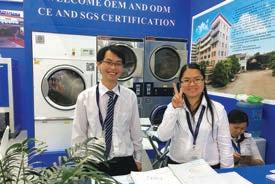
Kaminsky, who is a long-time veteran of doing business in the region, acknowledges some surprising shifts in relations in China.
“You don’t need a trading partner here to do business,” he reveals. “Here, it’s much easier to reach the top person at a company by phone and get a meeting, than it is wading through all the layers and e-mails in other places, including the U.S.”
The region’s burgeoning business and China’s welcome mat to international companies wanting to open plants and/or expand operations couldn’t have been more
Laundry Advances
Panel of Experts
NO VE MB ER 2017 Late News
www.americanlaundrynews.com Volume 43, Number 11 INSIDE [14] See FUTURE on Page 6
The Newspaper of Record for Laundry & Linen Management
apparent, from the glow of the giant downtown Shanghai skyline at night to the smiling, friendly way
of the local citizens.
[20] See TEXCARE on Page 10
Process changes and proactive strategies can help lower rewash rates.
Reducing Rewash
[16]
eye expansion into newly welcoming region
talk processing, personnel, business 10-20 years from now
experts
their advice on monitoring produc-
in the laundry.
Our
offer
tivity
(Image licensed by Ingram Publishing)
Flashing the peace sign is a way to say hello at Texcare Asia in a newly welcoming China. (Photos: Tim Burke)
laundry
In OPL 101, take a look at how the
process has progressed.
DUBOIS, Pa. — The Healthcare Linen Alliance, a collaboration among five providers of commercial laundry service management solutions for healthcare providers, has been formally launched, says Randy Bartsch, CEO of Ecotex.
Founding members of the Alliance include Ecotex Healthcare Linen Service Corp., Emerald Textiles, Logan’s Healthcare Linen Systems, Paris Healthcare Linen Services and Superior Health Linens.
“When we founded the Healthcare Linen Alliance, the concept was bringing together leading local healthcare linen and laundry service providers from
across the nation to join forces and provide the best of what they offer in their areas to a larger audience,” says Bartsch, who is also a founding member and chairman of the Alliance. “While each has their own diverse style and identity, the drive for best practices, the highest safety standards, cleanliness, service and environmental responsibility are the common threads that unite our group.”
The Alliance says it is one of the largest commercial healthcare linen services providers in the nation, serving nearly 1,400 customers and processing more than 340 million pounds of laundry per year. Through this partnership, the
Alliance offers its customers a new healthcare linen services option on a national level.
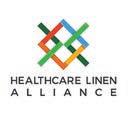
It serves an area covering Illinois, Indiana, Kentucky, New Jersey, New Mexico, New York, Ohio, Oklahoma, Oregon, Pennsylvania,
Southern California, Tennessee, Texas, Washington state, West Virginia and Wisconsin, as well as Canada.
The combined size, scale and coverage of the Alliance allows it to help drive down overall costs for customers, resulting in savings to the bottom line, according to the group.
Outfitted with technologically advanced and water-efficient equipment, the group is focused on innovation and the environment. Last year, the Healthcare Linen Alliance says that, as a group, it saved an estimated 398,970,000 gallons of fresh water across the communities it serves. ALN
Healthcare Linen Alliance formally launched Life-cycle analysis on isolation gowns gives advantage to reusables
MISSION, Kan. — Life-cycle analysis (LCA) research finds that reusable isolation gowns provide a significant improvement in energy, environmental footprint, water and energy-associated emissions, according to the American Reusable Textile Association (ARTA).
In addition, reusable gowns offer a 95% reduction in waste stream.
The life-cycle research was conducted on behalf of the textile services industry by Environmental Clarity LLC and compared the life
cycle of reusable isolation gowns versus disposables.
“The results of the isolation gown LCA support the conclusions from six other reusable/disposable studies that showed reusables provide a significant improvement in energy, environmental footprint, water and energy-associated emissions,” says Michael Overcash, Ph.D., of Environmental Clarity.
ARTA says disposable and reusable isolation gowns were studied from their inception as raw materials in the earth to manufacture of the coverall product to use/reuse
then to final end-oflife disposition. The scope and the results emphasize transparent, science-based life-cycle analysis. An abstract on the study is available.
The study found that choosing reusable isolation gowns instead of disposable alternatives decreases the environmental footprint in these ways:
• 28% lower natural resource energy consumption.
• 30% lower greenhouse gas emissions (measured as CO2 eq emissions).
• 41% lower total water consumed (blue water, which is water that is used and not returned to the source, representing depletion of a fresh water source).
• 93-99% lower solid waste generation at healthcare facility. End-users can count these improvements as a credit toward improving their sustainability programs.
In the study, an isolation gown was defined as a single-piece, size extra-large (XL) or one-size-fitsmost, long-sleeve, tie-up garment. The functional unit, or basis of comparison, was 1,000 isolation

gown uses in a healthcare setting. For the reusable gowns, this was 16.7 new gowns each used for 60 cycles; for the disposable gowns, this was 1,000 new gowns.
Two market representative ANSI/AAAMI Level 1 isolation gowns were investigated: a reusable polyester gown and a disposable nonwoven gown. The representative reusable gown weighed 240 grams (8.5 ounces) and was composed primarily of woven polyethylene terephthalate (PET) fabric. The representative disposable gown weighed 63 grams (2.2 ounces) and was composed primarily of nonwoven spunbondmeltblown-spunbond (SMS) polypropylene fabric. ALN
Publisher
Charles Thompson
Phone: 312-361-1680
E-Mail: cthompson@ ATMags.com
Associate Publisher/ National Sales Director



Donald Feinstein
Phone: 312-361-1682
E-Mail: dfeinstein@ ATMags.com
Editorial Director
Bruce Beggs
Phone: 312-361-1683
E-Mail: bbeggs@ ATMags.com
Editor
Matt Poe
Phone: 231-740-2842
E-Mail: mpoe@ ATMags.com
Production Manager Roger Napiwocki
Digital Media Director
Nathan Frerichs
Phone: 312-361-1681
E-Mail: nfrerichs@ ATMags.com
Advisory Board
Jim Buik • Greg Gurtler
Phil Hart • Janice Larson
Tom Marks • Gerard O’Neill Richard Warren
Main Phone: 312-361-1700 Fax: 312-361-1685
Subscriptions
630-739-0900 x100 www.americanlaundrynews.com
American Laundry News (ISSN 1091-9201) is published monthly. Subscription prices, payment in advance: U.S. 1 year $46.00; 2 years $92.00. Foreign, 1 year $109.00; 2 years $218.00. Single copies: U.S. $9.00; Foreign $18.00.
Published by American Trade Magazines LLC, 566 West Lake Street, Suite 420, Chicago, IL 60661. Periodicals postage paid at Chicago, IL, and at additional mailing offices.
POSTMASTER, Send changes of address and form 3579 to American Laundry News Subscription Dept., 440 Quadrangle Drive, Suite E, Bolingbrook, IL 60440. Volume 43, number 11. Editorial, executive and advertising offices are at 566 West Lake Street, Suite 420, Chicago, IL 60661. Charles Thompson, President and Publisher. American Laundry News is distributed selectively to qualified laundry and linen management and distributors in the United States.
© Copyright AMERICAN TRADE MAGAZINES LLC, 2017. Printed in U.S.A. No part of this publication may be transmitted or reproduced in any form, electronic or mechanical, without written permission from the publisher or his representative. American Laundry News does not endorse, recommend or guarantee any article, product, service or information found within. Opinions expressed are those of the writers and do not necessarily reflect the views of American Laundry News or its staff. While precautions have been taken to ensure the accuracy of the magazine’s contents at time of publication, neither the editors, publishers nor its agents can accept responsibility for damages or injury which may arise therefrom.
2 NOVEMBER 2017 | AMERICAN LAUNDRY NEWS www.AmericanLaundryNews.com MEMBERSHIPS INSIDE: November 2017 • Vol. 43 | No. 11 [4] Solutions to Stained Pillowcases Columnist Eric Frederick answers a reader’s question about difficult-to-remove pillowcase stains likely caused by lotion [8] Tools of the Trade [22] Effective Linen Customer Contracts How does a laundry make contracts that are legally enforceable, yet make customers happy? [24] The Future of Chemical Dispensing Systems Dispensers of the future will be able to order more chemicals automatically, schedule maintenance and more [26] Trade Ticker [28] Classified Advertising [29] Source Directory
providers in healthcare linen services collaborate on national level
isolation gowns good for environment, efficiency, study confirms
isolation gowns have a smaller environmental footprint than disposables, says a recent study.
Five
Reusable
Reusable
(Photo: ARTA)
Milnor has a better solution through dilution.
When Milnor introduced PulseFlow® Technology in late 2010, tunnel washing was thrust into the future. And traditional tunnel washing was left behind. The idea of balancing time, temperature, mechanical action and chemistry was missing one critical piece of the pie – DILUTION through the efficient use of water.
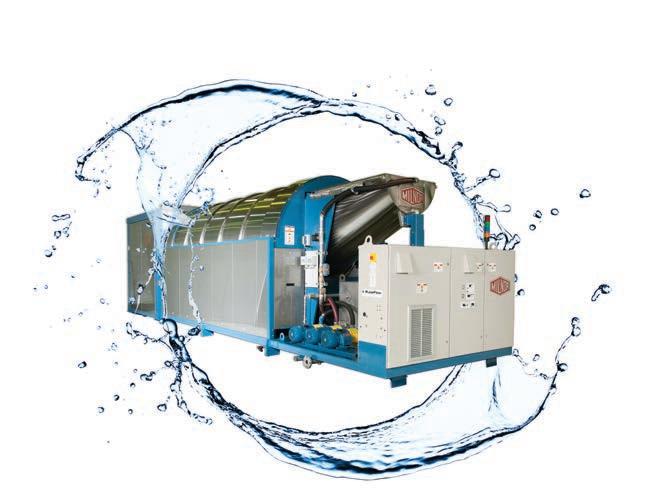
PulseFlow combines the innovative RecircONE® fast wet down and chemical immersion in the first module with standing bath washing in every spacious process module. Thorough and efficient dilution occurs by way of intermittent high velocity counterflow rinsing and traditional True Top Transfer.
The result is hygienically clean linen using less water (as low as 0.3 gallons per pound/2.5 liters per kilogram) and less energy as proven time and again by hundreds of PulseFlow tunnels in a variety of laundry applications worldwide.
Contact an authorized Milnor distributor or call 504-712-7656 to find out more.
www.milnor.com

Days of future past
If you happen to watch the X-Men movies, you’re familiar with the title Days of Future Past.
I know, mutants have little or nothing to do with laundry, but bear with me.
The movie came out in 2014. The name of the picture was confusing enough, but the movie? I still haven’t figured it out.
Well, the past, present and future of the laundry and linen services industry isn’t confusing at all, and several articles in this issue delve into each “era” of the industry.
Most likely, you’ve already seen the front-page feature on the future of the industry. I had the chance to ask eight industry representatives about the laundry of the future.
These individuals provided some interesting insight into the
The Editor’s Desk MATT POE
technology, the business and even what the laundry worker of the coming 10-20 years will look like.
You’ll find a more specific look at the future of chemical dispensers on page 24. John Goetz from Hydro Systems shares a brief history of dispens-

ers and then offers a look into what’s coming, including inventory management and predictive maintenance.
Bill Brooks from UniMac takes readers on a walk through the past 10 to 15 years in terms of OPL equipment advances on page 14. He shows how pushing linens from one side of the laundry has changed, and improved, over the years.

And the present? That’s where you are right now, and that’s what the rest of this issue is about, from industry events like Texcare Asia to Tools of the Trade (page 8) to tips to help create effective customer contracts (page 22).
It all comes together, past and present, to help your business now … and in the future. Keep it clean, everybody. ALN
AmeriPride Services launches first aid supplies provisions service

MINNEAPOLIS — AmeriPride Services, a textile rental and facility services company, has launched a fully managed first aid service that allows customers to quickly and effectively respond to first aid emergencies and injuries, the company reports.
The new service offers wall-mounted first aid cabinets, eyewash stations, individually packaged over-the-counter medicines, and motorist kits for fleet and mobile personnel to businesses of all sizes in various industries.
AmeriPride says it replenishes the first aid supplies as necessary to meet ANSI and OSHA regulatory standards and service log requirements.
“I’m thrilled that we are bringing a unique, costeffective solution to the market that genuinely eases the hassle and worry of running a compliant and safe business,” says Dave Rotman, vice president of marketing and supply chain for AmeriPride. “Our unique safety offering will help customers satisfy regulatory requirements and ensure their employees have the proper supplies needed in an emergency.”
First aid cabinets include hospital-grade products and prepackaged modules specifically labeled and organized for quick response and treatment of burns, eye wounds, serious wounds and resuscitation, the company says. Modules are designed so that even inexperienced first responders can effectively assist in an emergency situation.
Some of AmeriPride’s other safety products include slip-resistant floor mats, flame-resistant and high-visibility/enhanced-visibility uniforms, as well as restroom and cleaning products. ALN
READER QUESTION:
How to solve stained pillowcases
“We currently have a laundry for a 50-bedroom hotel in Ireland where we have about four to six pillowcases a day coming out of the wash with bright yellow staining on them. The staining is clearly a reaction with the detergent or bleach to an oil/makeup/ suntan lotion. This lotion is not being removed/broken down in the pre-wash, and it is then reacting with the detergent or bleach. The only way to get rid of this stain is to put it through a product from our chemical company called Lime-A-Way, which then breaks down the fabric because it is so strong.
“We are using the current company’s detergents and safe bleach. We wash in 60 C (140 F) with a 40 C (104 F) prewash. We had another provider before our current supplier and we left them as they could not find a solution to our problem either.
“I would be very interested to get some advice from you.”
“I RECOMMEND THAT YOU LENGTHEN YOUR PRE-WASH TO FOUR TO FIVE MINUTES, AND THAT YOU ADD A SOLVENT-BASED DETERGENT WITH A LITTLE ALKALI TO THE PRE-WASH. THIS TYPE OF PRODUCT IS GENTLE ON THE FABRIC .... ”
I do not find it surprising that, as a small account, the technical expertise of your local service representative is unable to handle such a problem. Your initial flush is good for the removal of all protein-based material that might get on the linen like blood or other body fluids. These tend to set and become a stain when the temperature rises above 49 C (120 F). So, we should be able to rule these out as a possible source of the problem.
I think you have correctly identified the source of the stain as an oil-based stain. Normally, oil-based substances on linen are removed through high alkaline levels and temperatures of 72 C (or at least 160 F). High alkaline levels and temperatures would not be needed for all your textile products, and it would be difficult to pre-determine which textile items require this treatment.
I recommend that you lengthen your pre-wash to four to five minutes, and that you add a solvent-based detergent with a little alkali to the pre-wash. This type of product is gentle on the fabric and will effectively remove any oil-based products on the linen. In this way, you are removing the potential stain before it becomes a problem.
This is a more traditional healthcare or industrial detergent than it is a hospitality-based product. Any major chemical supplier will have such a product. You will need to request it specifically and may have to wait a while until it is made available in your area. The additional cost of using this product should be covered by the lower textile-replacement cost.
The best way to defeat stains has always been to determine what wash process is required to prevent them from happening in the first place. This can often be a trial-and-error process, and unfortunately many local service technicians are ill-prepared to handle such a quest.
Changing chemical companies, as you have found out, often does not improve the problem. Conducting your own research and reaching out for advice is often the best way to solve the problem.
Eric Frederick has retired from active laundry management after 44 years. He is available as a laundry operations consultant. He is a past president and two-time manager of the year of the Association for Linen Management. You can contact him by e-mail at elfrederick@cox.net or by phone at 540-520-6288.

4 NOVEMBER 2017 | AMERICAN LAUNDRY NEWS www.AmericanLaundryNews.com
From
COLUMNIST AT LARGE Eric L. Frederick, RLLD
ALN
Top Stories Appearing on AmericanLaundryNews.com for the 30 Days Ending October 15 (WE) = WEB EXCLUSIVE NEWS • Washing Systems Acquires Clearbrook • Texcare Asia: China is ‘Open for Business’ • Ecolab Textile Care Signs Exclusive Agreement with ... • Healthcare Linen Alliance Formally Launched • Texcare Asia 2017 Opens to Big, Youthful Crowd (WE) COLUMNISTS/FEATURES • Getting Ready for Gen Z • Laundry Emergency Procedure Preparedness • Laundry Industry Companies Fill Openings • Eric Frederick: Increased Productivity Through Smarter Linen Purchases • OPL 101: Many Distributors Have Services to Offer Beyond Equipment OUR SISTER WEBSITES From AmericanDrycleaner.com: • Texcare Asia 2017 Opens to Big, Youthful Crowd (WE) • Me, Me, Me
(Clients’ Self-Esteem)
From AmericanCoinOp.com:
• Alliance Laundry Systems Launches Financing ...
• EnviroStar to Acquire Tri-State Technical Services for ...
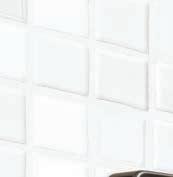

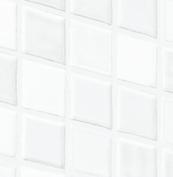


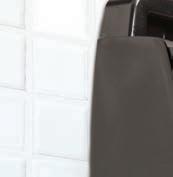
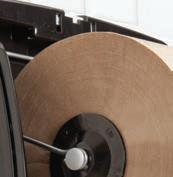

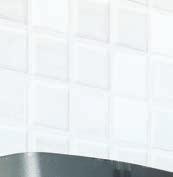

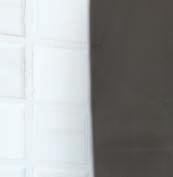

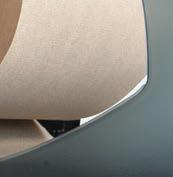
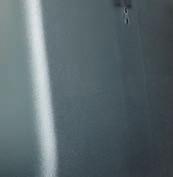










800 821 2221 americandawn.com | imagine@americandawn.com NO MINIMUMS. ADI is proud to announce our new product line of disposable paper products. With a variety of paper options and dispensers, we can help you service all your Customer’s needs. Same Day Shipping. No Minimums. ADI... We ARE the Difference!
equipment/procedures and more disciplined operating practices will also play a role in what the washroom will look like.
As is the case with all processing environments, change is often dictated by the inputs to the processing area. When we look at equipment, a great deal of the evolution will be governed by advancements in fabrics, aqueous chemical processes and how OEMs (original equipment manufacturers) address each to promote solutions that can do more with less (water, energy, chemistry, etc.).
The one thing that is for certain is that technology and these operating environments will not go unchanged. I can see equipment changing with these technological advancements, and quite possibly through the use of advanced materials of construction. Who would have thought 20 years ago that cars would have so many space-age polymers and materials like carbon fiber in them today?
JORGENSEN: Laundries will continue to be pressured for space and pushed for more production and efficiency per labor hour.
Equipment will become more compact and technologically advanced to conserve water, electricity and natural gas. It will also deliver more production per square foot and simpler operation.
Control systems will evolve to simplify management, servicing and maintenance of equipment. This will make it easier for management to keep tabs on laundry volume, efficiency, cycle lengths, pounds per operator hour, etc. Additionally, equipment operation will simplify, so entry-level and disabled workers can perform most functions. This is a trend we are seeing now.
BROOKS: Overall, I think we will see a focus on managing the labor dollar. This is the largest cost to running an on-premises laundry. Physical equipment and technology will unite to reduce labor costs.
CARTER: The laundry washroom in 10-20 years will maintain the similar laundry wash equipment components (washer-extractors, CBWs [continuous batch washers], etc.) that are currently used. The washerextractor/ CBW system will be robotically sorted and loaded into the washer and/or CBW system. The wash equipment will continue oper-
ating using water, chemistry and mechanical action.
I anticipate that water reuse and/or recycle systems will be one of the standard features of the wash aisle equipment that will significantly reduce water consumption.
The washer controls will be more efficient in optimizing fill levels and actively treat the water pH levels to improve maintaining consistent wash-quality results. In addition, the drying function could be incorporated into the washer operation and eliminate the separate dryer completely.
NETUSIL: The laundry washroom in 10-20 years will look very much like today’s washroom, with the exception of the number of batch washers used in lieu of washer-extractors, thus increasing the level of automation. Water will become even more scarce, which will drive the industry toward water-saving technologies, such as batch washers.
Textiles, chemicals and wash formula technology utilizing UV lights is rapidly advancing, which will ease many of the processing challenges we presently face. The components used will become more energy-efficient, reducing required resources.
We have always placed a heavy focus on the operational safety of our equipment; however, in the years ahead, this aspect will introduce a level of safety never seen before. The machinery controllers/ processors will become incredibly advanced. Troubleshooting, data tracking and remote services will further increase equipment’s uptime and user-friendliness.
WARE: Automation will continue to grow, and machines will get smarter and more predictive. This includes determining the health of the equipment and alerting the operator to what mechanical items need attention.
Laundries will continue to get bigger, as the cost of automation and labor savings may be costprohibitive for smaller plants. Environmental issues will affect how laundries operate and how the efficiency of the machines will improve with new technologies.
ANDRESEN: There is no doubt that the laundry business is already changing. There is an increasing focus on efficiency, sustainability and the workers. Because of that, the use of automation and robotics is increasing quickly. The machines will take over many of the heavy, fatiguing and monotonous tasks— in the long run. Machines will take over all the dirty work.
GRAHAM: One would think with all the artificial intelligence being developed and promoted that in another 15 years, we will be automated in most operational areas. I believe that we were in 2002, are in 2017, and will be in 2032, still a “blocking and tackling industry.”

While the current generation
is more inclined to want more automation in every aspect of their lives, it is difficult seeing this except in our plants. Equipment-wise, we will nibble around the edges over the next 15 years. ROIs (return on investment) will still determine our best path forward, not gut instincts.
What will a future finishing department look like? How will that equipment change?
JORGENSEN: There will be more options for feeding, ironing and folding systems, as well as growing compact options and all-in-one machines. Finishing is based on the volume of the application. Just like today, production automation will bring quality and production to finishing departments with improved ergonomics and fewer labor/operator tasks. Quality will get better and better thanks to new technologies.
BROOKS: In the finishing area, we will continue to see more automation, again with an eye on reducing the amount of labor necessary to perform the task. While finishing equipment is already getting smaller, I believe manufacturers will look to reduce the size of the footprint it takes up to make the pieces a fit for more laundries.
CARTER: No more employees required to operate the flatwork ironer and small-piece folder equipment. All of the current employee operations will be replaced with robotics. The heat source will be generated by microwave. There will be no need for guide tapes, so tape marks will be eliminated, resulting in a high quality of finish.
NETUSIL: If the minimum wage rate continues to climb as it’s expected, the level of automation in the handling of flatwork and fulldry goods will increase substantially. The European market faces this daily, implementing several levels of automation to decrease FTEs (fulltime employee) and increase PPOH (pounds per operator hour).

WARE: More automation will lower the number of employees, with the eventual implementation of artificial intelligence (AI) reducing the need for workers. As the potential for linen and fibers becomes more adaptive to wash



processes, the cost and energy to finish should improve.
GUDENBURR: Arguably, we are starting to see/ experience this today with the advent of microfiber being used in not only towels, but now bedding products. This is altering the plant design, and could eventually result in plants that have far less, or maybe even absent, the use of flatwork ironers.
Again, who thought years ago that clients would accept the use of baggers for folded smallpiece items? Today, many have altered their expectations, and/or their requirements, for said items.
The economy, and hygienic processing standards, may well play an equivalent role in what the future holds for this area. A strong economy drives the populace to desire the finer things, and as a result, we could see a resurgence in the F&B markets, and a higher demand for higher-end finishes.
This is good for everyone in our business, but we must remember when times are tough, buyers typically make the decision to source only what they need, and make tough decisions to compromise on quality in exchange for savings.
What’s coming in terms of laundry data, and how will laundries make use of that information?
WARE: Data will be the key to operating the laundry as cost pressures will continue to increase, and knowing that information in real time is critical.
Many systems will communicate with each other, talk to your providers, order products and parts when needed, and provide predictive direction by data-mining information faster than any human could. Knowing when a problem may occur and getting direction to correct it before all hell breaks loose will be important to successful operators in the future.
Today, many college and professional football teams use data mining to help prepare game plans. Helping to predict your competitor’s tendencies and preparing your team for the upcoming battle will soon come to our industry.
ANDRESEN: There are many obvious competitive advantages by controlling data. The laundry can ensure that they treat and wash the clothes properly so that it lasts longer. That is good both environmentally and economically, and you can do that when you track each article. Also, there is the possibility of reducing inventory to a minimum, where only what is needed is purchased. With tracking, there
is control over what is coming into the laundry and what is going out. When data about the individual piece or article is stored, the washing instructions can be easily adjusted digitally. In addition, there is a guarantee that the garment returns to its proper owner, and it is essential (for) all companies that have personal uniforms.
Finally, some clothes only last a limited amount of washing cycles before they need a replacement for safety reasons. Here, the system can keep track of when a replacement is needed.
GUDENBURR: Data is a topic that many in our industry are still lacking to grasp and efficiently make use of. There is a great deal of “lowhanging fruit” that can be captured and turned into profits through the proper use of data and metrics. As our industry catches up with others in this regard, data will and should play a significant role in all aspects of plant operations.
Changes will continue to come in how we expand access to information, how we present it so that it affords operators the ability to make timely decisions with it, and in how we simplify the architecture and systems designs associated with it so that information exchange between operating environments is seamless.
A great deal has been accomplished in this area, and the first step is getting plants to use it and make it part of the disciplines associated with running a plant in a proactive manner. As the use of data progresses, so, too, will the technology to feed the expanded appetite for it.
BROOKS: I think moving forward, we will see more on-premises laundries making use of this data to improve efficiency. Laundry management systems will become the norm. Access to data has impacted so many businesses and departments within them.
Laundries will continue to embrace this level of technology and reduce operating costs.
CARTER: Laundry data will be economically scalable, meaning different levels of laundry data-reporting systems will be easily available to small laundries and large laundries at an affordable cost. Laundries will focus on real-time data that will report exceptions to the expected laundry operation, allowing the laundry operators to focus on their customers with fewer employees.
Where do you see changes in terms of tracking?
BROOKS: RFID (radio frequency identification) is already being used in many areas. For instance, it is, and will become, hugely beneficial in the fire industry to track the service history of PPE (personal protective equipment). I could see this also coming over into health-
6 NOVEMBER 2017 | AMERICAN LAUNDRY NEWS www.AmericanLaundryNews.com
Continued from Page 1 Future
See FUTURE on Page 12
(Image licensed by Ingram Publishing)
Brooks
Jorgensen
Andresen
Carter

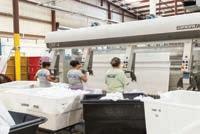
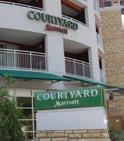



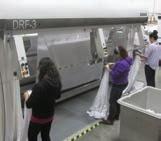
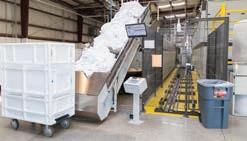


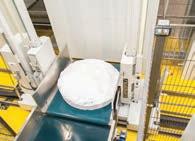
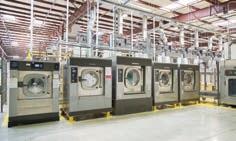

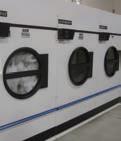
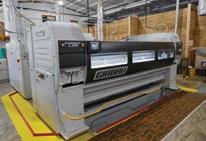

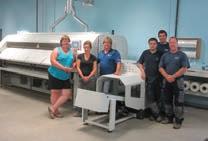
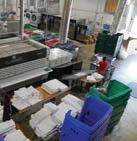












































































































By embracing a stepped approach to laundry automation, Whistler Laundry increased production 90 percent in just under four years. THE COMMERCIAL LAUNDRY STARTUP ADDED EQUIPMENT AND AUTOMATION AS IT GREW — IMPROVING PRODUCT QUALITY, BOLSTERING PRODUCTIVITY, CAPTURING NEW CLIENTS AND LOWERING LABOR COSTS. (800) 256-1073 • www.girbauindustrial.com INDUSTRIAL INCREASE THROUGHPUT. IMPROVE PRODUCTIVITY. BOOST PROFIT. INNOVATIVE LAUNDRY SOLUTIONS
Tools f the Trade
Plastic laundry cart sheds pounds to save fuel

Fibertech Inc., a manufacturer of custom-engineered plastic products, is now offering a lighterweight laundry truck (LLT67), the company reports. According to Fibertech, the new truck maintains the benefits of its standard model while being considerably lighter.


The company says the new laundry cart is 12 pounds lighter than its standard model, which adds up to fuel savings when it comes to transporting fresh linens to and from clients. One of the main ways Fibertech says it engineered this lightweight, yet durable, cart included reducing the wall thickness to .200 of an inch compared to the .250 of an
inch on its standard laundry cart.
According to the company, the laundry cart design is crafted from a high-density polyethylene, which allows the cart to keep its strength and rigidity while also being lighterweight. Like standard laundry carts, Fibertech says its lightweight laundry trucks are still crafted from a one-piece rotationally molded design, so there aren’t weak points that can harm the integrity of the product.
Another feature of the lightweight laundry carts is a standard metal base, which is added for greater strength and durability. www.fibertechinc.net 888-737-3960
Leonard Automatics’ cart washer is now powered by the EPAapproved Viking Pure System, according to the company. Leonard says the system protects against and kills, in seconds, all known bacteria, viruses, fungus and antibiotic-resistant superbugs.

The company says benefits of this system include:
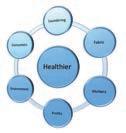


• Processes carts in half the time.
• Reduces water consumption.
• Costs pennies per wash.
• No additional chemicals; no mess.
• Self-contained, compact design.

The system uses electrolyzed water, which is the result of a process called electrolysis. It is the process in which salt (NaCl) in the brine is electrically separated into its two main ions: sodium (Na) and chlorine (Cl). Those two ions are then mixed into two separate streams of fresh water, thus making two useful solutions, Leonard says: hypochlorous acid (HOCl, a strong sanitizing solution) and sodium hydroxide (NaOH, a powerful cleaner/degreaser).
www.leonardautomatics.com 704-483-9316
A new condensing boiler, the Free Flex Ultra-High Efficiency Commercial Condensing Boiler, is available from Bryan® Steam LLC


According to the company, Free Flex offers a thermal efficiency of 95% and features Bryan Steam’s weld-free design. Free Flex permits field access to the heat exchanger for cleaning and an unprecedented tube replacement, which the company says makes it the only repairable condensing boiler available.
Cleaner Solutions says its CLEANOVATION Laundry Care System is a 24/7 self-cleaning, defending solution that reduces unwanted fabric-degrading bacteria and bio-burden to keep fabrics hygienically cleaner and fresher while in service. In addition, Cleaner Solutions says the system makes rewash easier and extends the life and quality of the fabric.
The company says its BALANCE detergent is an integral part of the system. It works at lower temperatures, according to Cleaner Solutions, with a cellular and enzymatic
Fashion

Bryan Steam also says that Free Flex is available in knockdown configurations to fit where other packaged boilers cannot, and will operate in low-flow, variableprimary or traditional primary/secondary designs.
Other features include 1-3 MBH; a competitive installed footprint; a stateof-the-art control system; and Bryan’s Thermal Shock Lifetime Guarantee. www.bryanboilers.com 765-473-6651
technology that is highly biodegradable.
The system also features MICROSTATIC, an antimicrobial finish protection that is easy to clean and apply, according to the company.
With CLEANOVATION, Cleaner Solutions says laundries become manufacturers of bioburden-reduced linen with permanent antimicrobial protection. www.cleanersolutionsllc.com 301-332-5760








Women in Healthcare




Hydro Systems, an independent manufacturer of proportioning and dispensing systems, launched its Dositec Value Calculator on its website, the company reports.

The calculator helps users estimate the cost savings realized with Hydro’s Dositec systems in comparison to traditional 1-to-1 dispensing solutions, says Hydro Systems. Users input washerextractor capacities, chemical information, labor information and more to get an on-the-spot savings and return-on-investment calculation.
“Many large facilities are missing out on cost and productivity savings because they are installing and maintaining numerous individual dispensers
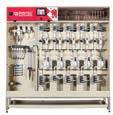






versus a single, central dosing system,” says John Goetz, global product manager, Hydro Systems. “The Dositec Value Calculator easily highlights the anticipated cost savings of the Dositec systems for laundry operators and chemical providers alike so that they can better understand how to improve their operations.”
Earlier this year, the company says it launched the Dositec Electromagnetic Multi-Washer System, a system designed for on-premises laundries with washers below 125 pounds that may not have access to compressed air.
www.hydrosystemsco.com 800-543-7184







8 NOVEMB E R 2017 | AMERICAN LAUNDRY NEWS www.AmericanLaundryNews.com
Chemical dispenser cost-savings and ROI calculator introduced
Seal
Outfitting
most extensive line of women’s lab coats in the industry SimplySoft ® Scrubs Fashion forward styling designed just for women Vibrant new colors with flattering features A luxurious brushed fabric with a soft, comfortable feel Industrial-Laundry friendly Almost Half of All Medical Students are * Embroidery available on all garments with fast delivery Women Nearly 1/3 of Practicing Physicians are Women (888) 491-5818 www.FashionSealHealthcare.com info@FashionSealHealthcare.com ALN_Tab_1-4_H.indd 1 5/16/17 10:35 AM
Healthcare®-
The
now powers cart
Condensing boiler boasts 95% thermal efficiency Laundry care system said to make laundries ‘manufacturers’
EPA-approved electrolyzed water system
washer
Notice Anything?















InkGo® Is Now Odor Free!






InkGo has been reformulated to remove its odor… and to improve its performance.





















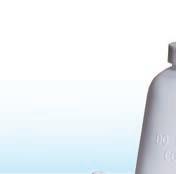

InkGo is still the environmentally friendly,* safe way to remove ink stains from all types of fabric. It’s still great at removing autoclave tape and adhesives. And since it’s odor-free, InkGo is more pleasant to work with.



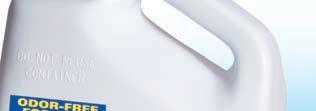
Does odor really matter? As more drycleaners position themselves as good environmental stewards, keeping chemical odors in the plant to a minimum can help them differentiate from their competition. And odor-free is a real plus if you’re working on ink for an extended period of time.





Now that’s worth noticing!
*InkGo is Biodegradable and is California Prop-65 and California VOC Compliant.







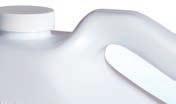


Become a STAIN WIZARD at ALWilson.com
To learn more, visit ALWilson.com or call 800-526-1188 A. L. WILSON CHEMICAL CO.


About
Texcare
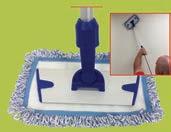
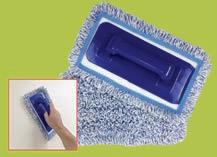
Inside the Expo Center, the show aisles were crowded with attendees from many countries, and a youthful feeling was running through the halls. Some booths, such as Firbimatic, Sankosha, Bufa, Kannegiesser, Forenta, Colmac and Miele, just to name a few, were busy, sometimes crowded enough to block the aisleways, always a strong sign.
“There are so many opportunities we’ve noticed this year at Texcare Asia,” says Ian Ruxton, an attendee and owner of Wash Comm Co. in Queensland, Australia. He attended for the 11th time, “looking for ideas, seeing lots of quality control in equipment and products and an amazing amount of new innovation at the show.”
Show organizers Messe Frankfurt (Shanghai) and the China Light Industry Machinery Association (CLIMA) kicked off the show with a message that said, basically, China wants the world to know today it is a player arriving on the international scene and welcomes business.
Exhibitors at Texcare Asia confirmed that message. In booths such as Germany’s EazyClean; Morristown, Tenn.-based Forenta; Colville, Wash.-based Colmac, as well as companies such as Jensen, Firbimatic, Millennium, and others, the show chatter was about market opportunities in China.
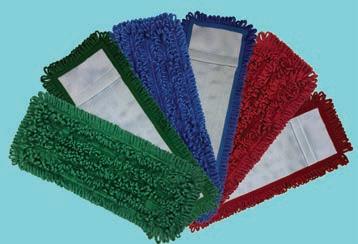
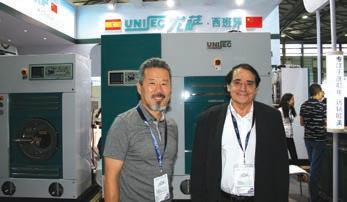

Richard Li, general manager of Messe Frankfurt (Shanghai), talked to a packed welcome reception crowd about the joint effort between Messe Frankfurt (Shanghai) and CLIMA to promote “high-quality global exhibitors and visitors who will benefit at
Texcare Asia 2017 through meetings, educational, and onsite intervention during the fair.”
The event filled 215,000 square feet of space in two halls and attracted 171 exhibitors and an estimated 11,000 attendees, notes show organizers.
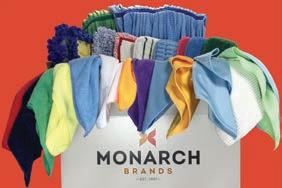
Opportunity, innovation and growth were words heard often to describe Texcare Asia this year.
Simon Nield, president of Panama CityFla.-based Jensen USA, seemed to concur, pointing out that potential growth in Asia is strong, and he’s hearing “talk of opportunity and innovation across the show floor, a great sign.”
Elgar Straub, managing director of Munich, Germany-based VDMA, an association involved in textile care, fabric and leather technologies, seemed to sum up this year’s Texcare Asia 2017 goal with this: “We will continue to promote the development of China and Western Asia.”
Others attending this smart-looking, clean, well-organized trade show reflect similar opportunistic sentiments. China has its arms open to international businesses.
“The company Alsco, for instance,” Kaminsky adds, “is opening multiple plants in the region, and Cintas is now coming here to open a new plant soon.”
Albert Lee, owner of Woodside, N.Y.based J’s Cleaners and a National Cleaners Association (NCA) board of director, notes, “China is high-tech and advanced compared to other countries. This is my first show in China and I am impressed with the growth. People have power to spend and that’s the key.
“I came here looking for automation and found it. POS, conveyors, the whole big picture, and I’ll bring back ideas.”
10 NOVEMBER 2017 | AMERICAN LAUNDRY NEWS www.AmericanLaundryNews.com
Continued from Page 1
Albert Lee (left), owner, J’s Cleaning, from New York was “impressed with the growth” of Texcare Asia 2017. Here, he poses with Roman Prado, president of Unisec.
Wallwashing Mop • Lightweight extendable ‘hand mop’ for reaching elevated grime. • Telescopic pole (from 28” - 48”) • 360° swivel maneuverability • Starting at $2.45/frame, $2.25/telescopic handle, and $1.39/pad Handy Trowel • Ergonomic chisel tipped trowel handles stuck-on grime • Use on vertical and horizontal surfaces • Starting at $3.00/trowel and $1.39/pad Introducing our 10” Multipurpose Microfiber Pad System NEW Mesh Backed Side Pocket Mops • 100% microfiber mesh backed for a stretched snug fit • Quicker mop drying times due to mesh construction • 18” Mop fits your existing pocket mop frames • Starting at $2.40/mop Serious
Microfiber. Professional quality products at consumer friendly price points. Our microfiber product lines grow year over year to better serve you as your customers’ cleaning needs evolve. If you’re as serious about microfiber as we are, try us out. Call 215 482 6100 and talk to us about your specific needs. We will send you a sample kit and catalog so you can experience Monarch Brands microfiber for yourself. Minimums apply on all advertized prices.
Texcare Asia attendees watch a demonstration at the Jensen booth in the Shanghai New International Expo Center. (Photos: Tim Burke)
Overall, Texcare Asia was thoroughly friendly and welcoming to attendees from all over the world.


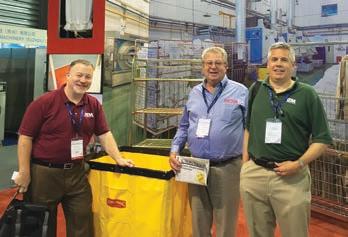

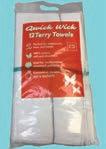



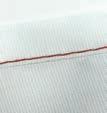



One look at the glittering Shanghai skyline at night from “The Bund” or a drive around the clean and tidy local roads filled with new Mercedes and Tesla cars told anyone paying attention there is money being made here and
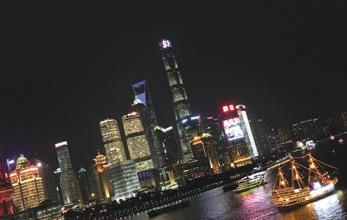



is flowing in, and more is quite welcome.
In short, China is open for business. That message was exemplified by Texcare Asia 2017.






www.AmericanLaundryNews.com AMERICAN LAUNDRY NEWS | N OVEMBER 2017 11
The well-lit skyline of Shanghai, China, rises into the night and makes a great photo from “The Bund,” a bustling and friendly “strand” type walkway along the Huangpu River.
Someone who does business in China, Joe Kaminsky (center), GM at Hialeah, Fla.-based Everstrong, chats with Associate Publisher and National Sales Director Don Feinstein (left) and Editor Tim Burke.
Specifically Designed For Hospitality • Made with USA Cotton in Bangladesh • 4 Core Hospitality Towel SKUs • Cotton/Poly Blend for Softness & Strength • Airjet shuttleless construction • Consistent product box after box • Optically bright white • Call for pricing Lulworth 200 Sheet Collection • Made in China with colored threads to easily identify the sheet sizes • Crease-resistant 60/40 cotton/poly blend • Woven on airjet looms and tested for strength and performance • Carton packed & guest ready • Sheets start at $68.09/dz True Color Towels • Designed for clubs, spas, gyms, and institutional facilitites • 100% Soft ring spun cotton • Matching dobby borders • Starting at $34/dz bath, $9.75/dz hand Monarch Brands’ route ready bar mops help laundry managers alleviate capacity constraints and boost cost-effective operations. We save laundries the time and expense of pre-washing and counting out new bar mops before their ‘first route’. Typically, laundries save at least 70¢ per dozen in washing and packing expense alone. Call 215 482 6100 to learn more. Our best bar mops packed for online sales, and point-of-purchase displays • Attractive Retail Packaging • Pre-Washed & Folded • Convenient Carrying Handle • Starting at $2.71/bag GOT BARMOPS? Qwick Wick Terry Towels We Know Laundry Textiles. Some of the biggest brands in the industry trust Monarch Brands with their textiles needs. Shouldn’t you? Call 215 481 6100 or visit monarchbrands.com to start a conversation. FULLQUEENKING
Exhibitors at Texcare Asia confirm that China is a player arriving on the international scene and welcomes business.
interest
international
ALN
American Drycleaner
Tim
Burke is editor of sister publication
This “Retoucherie” (means dry cleaner) in the Shanghai Pudong district of the city is a good representation of clean, tidy, welcoming China.
care and hospitality, where towels, sheets and other linens and loads are tracked as an aid to knowing when they need to be pulled out of service.
CARTER: Tracking laundry data will be cloud-based, real-time, allowing management the opportunity to improve production in real time. Laundry will be processed using “just in time” techniques, allowing management the opportunity to eliminate excessive linen-inventory investment.
NETUSIL: RFID UHF chips will become a standard feature on new linens from the manufacturers. Handheld scanners and tracking software within each laundry will be commonplace.
WARE: The tracking of linens, productivity and costs will be real-time, so managers can act immediately when there are issues. Knowledge of the complete inventory throughout your network and how to reposition these items in real time could save laundries significant time and money in distribution.

Knowing immediately which process or piece of equipment is not up to standards allows you to react to the issue, rather than reviewing the results at the end of the day or the next day. If a laundry is going to miss a production target by a few thousand pounds, it would be important to know this information as it happens so you can correct it immediately.
ANDRESEN: RFID chips and similar technologies will develop and become smaller, more efficient and cheaper. We will see an increased use of visual recognition of those products where chips are not suitable for one reason or another.
GUDENBURR: Chip technology, and the next generation of said technology, will play a significant role in operations. We all have seen the benefits of being able to accurately track what comes into the plant, how it moves through the plant, and what goes back out to the end-user. This will only expand to the point where processes will be able to track all aspects of a piece of linen, garment or mat.
There still is a significant opportunity to reduce waste, theft and premature linen disposal. To put things in perspective, all are far costlier than some of the nominal savings that we tend to focus our energies on. As these technologies evolve, and the costs associated with them come down, they will dominate the landscape. Also, the information that comes from this could well influence the next generation of equipment and processing advance-
ments for the industry.
What do you think the laundry employees of the future will look like? What will their tasks be? What skills will they need?
GUDENBURR: As plants automate and eliminate labor-intensive manual tasks, employees must be “top-graded” from the perspective of skills needed. Today, our best operators understand this and have already elevated the capabilities of their team members, and paid up to make certain that they not only can hire such talent, but, more importantly, retain it.
Automation drives a higher level of technical aptitude and the need for more specialized skills. This is not to say that general maintenance capabilities will not be required; this is far from the case. Equipment will still leverage motors, pumps, bearings, compressors, solenoids, PLCs (programmable logic controller), etc. It is simply the fact that these will become more advanced, and as such, those who interact with them must advance with them.
This will require a bit of a paradigm shift for some plants, especially if they want to optimize their ability to compete and remain profitable.
BROOKS: With all the technology being built into equipment now and into the future, it would be easy to say that employees will need to be more tech-savvy. However, I think it’s the opposite. Automation and management’s access to data will take much of the decision-making out of employees’ hands. The work should become less technical.
JORGENSEN: I think laundries will be able to hire more entry-level and disabled workers as equipment operation simplifies over time. The time and expense involved in employee training (to get employees up to standard production) will also reduce as a result.

CARTER: Robotic employees will be employed in the next 10 to 20 years. As a result of robotics, the new laundry employee will be college- or technically educated, computer programmers and/or computer hardware technicians, working in a control center overlooking the laundry operation. They will be responsive to maintaining the robotic activity and address/eliminate any production bottlenecks in real time.
NETUSIL: From the operator standpoint, pretty much a carbon copy of what we see in today’s laundries. The reason is that equipment will become even more user-friendly, allowing management to staff positions with a more readily available team of non-skilled labor. From the maintenance and engineering staff point of view, with higher levels of automation comes the requirement for a higher skill set.
Twenty years ago, the maintenance and engineering team member skill set was more in the mechanical realm. Today, and in the years to come, the required skill set will be in both the mechanical and computer/digital realm.
We think the tasks will be pretty
much the same as in today’s laundry. Perhaps the more mundane, repetitive tasks will be automated, leaving human intervention to perform the tasks that require a little more thought. The biggest differences will be in the cart make-up area with sorted stacks of tracked goods being delivered to specific pickup points, and, of course, the increased production levels due to automation.
WARE: As the industry moves to more and more automation, the laundry worker of the future will need to be more skilled in operating systems and processes. Similar to an auto manufacturer where 20 years ago a plant would require 5,000-6,000 workers to operate, today’s auto plants now utilize workforces of 2,000 or less. Many of those employees are managing the machines that build the cars and not physically doing the work.
If laundry companies could build and operate plants with almost no employees, they would. It will require a better educated, more technically savvy employee to manage the automation in a production process.
ANDRESEN: The laundry of the future is a much more attractive workplace, where employees will focus on management, quality assurance and developing their customer service concepts.
GRAHAM: This is our most serious challenge, and in 15 years, the millennial generation will dominate the work landscape. What to do? Millennials in 2032 will fall between the ages of 28 to 50.
Start today in understanding who they are, what they want and what they bring to the table.
Also, do you venture into the plant and talk to your teammates? Do you greet service reps in the afternoon or on a cold January morning? Lastly, are you providing all the safety gear and education that you need to keep people gainfully employed? In 2032, these will still be the basics.
How do you think the changes to come will affect the business side of a laundry? How will marketing, sales and management be impacted?
GUDENBURR: The fundamentals of business never change as it pertains to costs, profits, quality and service. The changes will be in how the advancements in products and in the processing areas alter how these fundamentals are presented to decision-makers.
Marketing plays a key role in every industry, and as I think most know, a great deal of marketing can be pomp and circumstance with minimal substance. The hope that I would have is that our industry focuses on science and substance as it markets, and as it makes business decisions. Doing so will always have
a positive impact to the bottom line, and to the health and welfare of the business.
BROOKS: Distributors will become less of equipment sales and service organizations and more focused on providing total laundry solutions. So instead of just selling a $20,000 piece of equipment, they will become a partner, helping onpremises laundry managers run a $200,000 operation and drive efficiency.
CARTER: Higher linen quality, consistent scheduled linen deliveries, additional customer services offered to accommodate customer site linen management services.
NETUSIL: This question takes us back to the expected minimum wage increase. Laundry operators will be required to work smarter, not harder. For those who plan to remain in the industry, they will be wise to take the appropriate steps as soon as financially possible toward minimizing their FTE count and their resource usage, thus maximizing their profit margins to ensure their solvency.
The era of outsourcing and consolidations is upon us once again. The large independent and national/corporate operators who are operating with large daily production volumes are processing at much lower costs than a smaller independent can because they have already taken the steps to minimize their FTE count and resource usage. Therefore, they are able to offer unmatchable price levels and service.
In 10-20 years, millennials will be in ownership and management positions. Online marketing and sales is the go-to method for this generation, so we have to be ready now with tons of online information for their use. This is their first stop in researching options and alternatives, and they make their decisions quickly. They are used to instant gratification due to the available mobile technology.
WARE: Laundries will need to be more integrated with their customers and their needs. Having linen rooms that know the exact inventory at any one time can reduce handling, lower inventory costs and improve servicing the locations that need the product. Hopefully, the reduction in inventory, usage and costs to the end-user will help result in laundries being able to charge for the services provided.
Marketing and sales will need to be more results-based than servicesbased. Customers will want the laundries to be more integrated into their service model, rather than just
a supplier of products.
ANDRESEN: Inventory control is the major focus area today, and as technology and data management improve, businesses will be better and better at managing their costs. The technology offers many possibilities, and the skilled laundries will understand the cultivation of their core areas.


I assess that future laundries will become highly specialized. You should not just be good at washing workwear; you must be very good at washing a specific type of workwear.
What other changes do you see for the laundry of the future?
WARE: If only we had a working crystal ball. Unfortunately, due to the high costs of development, the industry is not on the cutting-edge side of technology, nor the R&D of automation and AI. But the industry will need to search for solutions in other fields and incorporate those findings into the equipment and processes of the future.
While tremendous strides have been made, the industry is 10 or more years behind other large-scale manufacturing companies in terms of automation and the reduction in labor and costs. As labor and utilities become more critical in the cost of operating laundries, new solutions will be developed to generate tremendous returns.
GUDENBURR: As an industry, we need to make certain that the services that we provide to the textile, healthcare, hospitality and industrial markets remain competitive and “must have” in nature. Additionally, we have to continue to look for ways to expand our reach and possibly the portfolio of solutions that laundries offer to their end-users. By doing so, we avoid or minimize commoditization, and afford processing facilities the ability to remain profitable so that they can continue to fund strategic investments.
What we can’t do is become complacent, or assume that what we do today will be acceptable or competitive tomorrow.
BROOKS: All laundries will be operating within best practices due to the expansion of technology and data. So, from that giant five-star hotel, to the small local hotel, to the fire department, to the long-term care facility, all will be able to produce exceptional quality.
The process will become virtually foolproof, which will mean longer linen life (because it is being handled correctly every time) and better management of labor (with lower costs).
CARTER: Government regulation will increase significantly, influencing wash times, water consumption per pound, etc.
ANDRESEN: Compared to just five years ago, there is significant development in the laundry industry. Previously, companies were somewhat conservative in investing in and utilizing new technology, but that’s definitely not the case anymore. You could say that the future has begun.
12 NOVEMBER 2017 | AMERICAN LAUNDRY NEWS www.AmericanLaundryNews.com
ALN Continued from Page 6 Future
Graham
Gudenburr
Ware
Netusil
Ultra and Nanofiltration: The Modern Solution for Ultra Clean Water.

It’s a whole new way to filter water. Using our exclusive hollow-fiber ceramic membrane, the PurePulse® system operates in the lower end of the ultrafiltration range into nanofiltration. Filter total dissolved solids and dyes as small as 5 nanometers – no need to cool water. This is innovative membrane technology for the modern age.
Recycle 70-80% of your facility’s water
Filter your water while it’s hot, saving energy
Self-cleaning ceramic membranes have 10 year warranty Reliable and long service life
Less expensive than RO technology
Affordable, low running costs and fast ROI

PurePulse system has a small footprint that won’t change as you expand with additional, stackable membranes.
Patent pending.

504-712-7700
www.PurePulseSystems.com
Do you think not much has changed in laundry operations? Think again
DIALING IN THE DRYING SIDE
Over the last decade, technology has taken dryers from a utilitarian tool to a smart machine contributing to overall better quality and even better efficiency.
BY BILL BROOKS
RIPON, Wis. — It’s just laundry. Items come into our area dirty. We then throw these loads in a washer to clean them. They come out wet. We throw them in the tumble dryer and remove that moisture. Pull them out, fold (finish) and get them back in service. There it is. In just 43 words, I described the entirety of what goes on in an on-premises laundry.
So, if I can walk you through the basics of how a laundry operates in a handful of words, how much innovation can be brought to this? I mean, has there really been much new technology introduced to the laundry in the last 10 to 15 years? Is there anything that is changing how we operate? Are there any features that make life easier or improve quality? Is my laundry more efficient today than 10 or 15 years ago?
While it may not seem that way, the industry and equipment most certainly has changed how we push linens out the other side of the laundry.
DELIVERING THE DATA
Access to data and information on the overall laundry has offered a window into how these departments operate, but the sheer amount of data we are able to see has changed how the laundry runs.
Laundries years ago, and many facilities even today, just processed loads without an eye on efficiency, overall costs or whether the proper processes and cycles were being used.
Technology over the last few years has risen to a point where management has a total view of the laundry operation. Many of these new systems even offer a real-time look at the laundry, where they can see what machines are running.
Data collection has changed the operation, bringing greater clarity and accountability. Laundries can now see where their costs are, identify areas to improve, compare against other facilities (if part of a larger chain) and much more. The bottom line is that management now has all the information to run the operation like a business—reducing costs, increasing productivity and recognizing areas where training is necessary to improve processes.
Just think about how something as simple as a report showing the highest temperature reached in a cycle can be important in the healthcare industry, as standards governing this begin to take root to prevent the spread of infection. Today’s laundry management systems put this information at management’s fingertips. Years ago, staff might have been filling a cup to measure the temperature.
Years ago, the term “bone dry” was pretty appropriate to describe how towels and other linens emerged from the tumble dryer. Operators cranked the dial as far as it would go and dried every load to the maximum, regardless if the linens required that. We now know that over-drying actually degrades the fibers, and that contributes to a reduction in the life span of the pieces. In addition, it wastes labor (loads are in the tumble dryer longer than they need to be) and gas.
Technology changed all that and took the operator error out of the equation with moisture sensing. Now management can set the units to dry to a specific moisture level. The machines have become so smart that once the prescribed moisture level is reached, the unit shuts off. Linen life is extended, and the operation as a whole reaps additional savings.
In addition, the drying process has evolved as well. No longer are today’s units blasting loads at maximum heat for the entire duration of the cycle. Many now employ a step drying process that dials back heat as the load approaches the proper moisture level.
Fire suppression systems were another welcomed feature added to tumble dryers in the last 15 years. In the unlikely event of spontaneous combustion, this feature helps keep any fire contained to the cylinder by spraying water on it and sending an alert message to a manager.
RAMPING UP THE SPIN SPEED
Speaking of reduced drying times, increased spin speeds, particularly among hard-mount washers, have been another welcomed development over the last 15 years that have helped reduce drying times.
er drives has also yielded a gradual rampup of speed that reduces electrical draw— another cost savings.
Technology has also ensured even outof-balance loads reach the maximum extract speed, by going through additional rebalancing if the load calls for it.
CONTROLS THAT MAKE SENSE
Remember those faded posters taped, crookedly (in most cases), to the wall that displayed the cycle codes for staff to punch into the laundry equipment keypad? Seen them lately? Gosh, I hope not, or your laundry is seriously overdue for an equipment upgrade.

Controls today use real words. No more operator error picking the wrong cycle. For example, the towels cycle actually says “towels,” the heavy-soil sheets cycle is identified as such, and so on. It seems like a small advancement, but as anyone who has worked in an on-premises laundry knows, it is anything but. In addition, some controls also have the cycles listed in multiple languages—a welcomed feature for bilingual departments.
Previously, operations were burdened with the standard 140-G-force extract speed. Better manufacturing techniques, such as plasma cutting and robotic welding, have delivered tighter tolerances and, as a result, washers capable of handling higher spin speeds. That’s led to hardmount washers that produce extract speeds of up to 400 G-force. The advent of invert-
Within those controls reside greater flexibility as well to tailor wash cycles for the best quality results. For example, in the firehouse laundry, where any number of wash variables could impact the integrity of PPE, cycles, including maximum extract speeds and temperatures, can all be dialed in to protect these high-tech fibers.
And when it comes to service, controls can tell maintenance

staff or servicers the last time the machine was serviced, when preventative maintenance was performed, offer troubleshooting information if a problem comes up, and much more. The benefits are a longer life of the machine, fewer service calls and generally reduced repair costs because technicians are able to diagnose issues more quickly.
FINAL THOUGHTS
Yes, water still flows into the wash cylinder, sloshes around and is spun out. True, the heated air is blown through loads in the tumble dryer and they emerge ready for finishing. What we do in an onpremises laundry hasn’t changed in the last 15 or so years. How we do things, however, has changed considerably and made the entire operation far more efficient, qualityfocused, and significantly more streamlined.
Our industry has definitely progressed to a point where managers are truly equipped with all the information and machines to dial in processes to deliver the highest quality and hygienic results. No longer are laundries looked at as strictly cost centers. Advancements have helped them achieve a place at the table as contributors to the bottom lines of the facilities they serve. ALN
Bill Brooks is North American sales manager for UniMac®, a provider of on-premises laundry equipment. To learn more about UniMac, visit www.unimac.com/ opl101 or call 800-587-5458. Brooks

14 NOVEMBER 2017 | AMERICAN LAUNDRY NEWS www.AmericanLaundryNews.com OPL 101
Industry, equipment has changed how laundries push linens through
“HOW WE DO THINGS ... HAS CHANGED CONSIDERABLY AND MADE THE ENTIRE OPERATION FAR MORE EFFICIENT, QUALITYFOCUSED, AND SIGNIFICANTLY MORE STREAMLINED.”
— BILL BROOKS UNIMAC
(Image licensed by Ingram Publishing)
MAYTAG® COMMERCIAL LAUNDRY HAS REINVENTED THE TOP-LOAD WASHER.

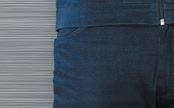


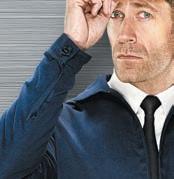


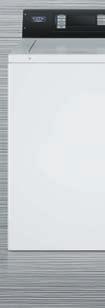









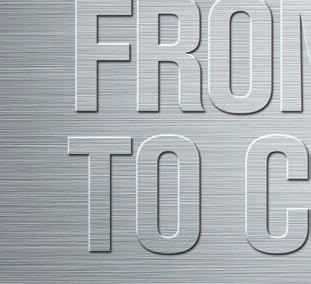

When we say it’s a whole new top-load, we don’t just mean it’s got a ½-HP PSC motor, traditional flex-vane agitator and heavy-duty cabinet for extra-rugged reliability—which it does. It means we started at the beginning and gave it a dedicated production line in our Clyde, Ohio manufacturing facility. And, we’ve got more service techs at the end of the line, so that downtime? It’s a thing of the past. Plus, with full programmability, your owners can squeeze the profit out of every last load. Now that’s dependability—from build to clean.
DISCOVER THE NEW MAT 20 AT MAYTAGCOMMERCIALLAUNDRY.COM






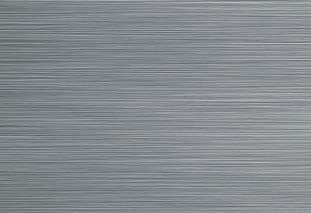




®/ ™ ©2017 Maytag. All rights reserved.
PANEL OF EXPERTS
Evaluating laundry employee productivity
doing so. If you can’t obtain a piece count, then count bulk items, such as finished carts, completed routes or bundled goods; performance against the standard may fluctuate when moving from large to small “units,” but the numbers will normalize over a day or week to give you a picture of performance.
and should be presented at the point of use: performance numbers on an individual process to the operators; target versus actual throughput for a department to the supervisors; PPOH for the entire plant to management; etc.
Technology enhancements continue to provide new opportunities for automation in the washroom and throughout the laundry, but personnel are still key to the operation. Anyone familiar with Spindle or myself knows that productivity is a topic that is “near and dear.”
Whether you have just installed new equipment or are looking at established processes, setting and tracking standards is a priority. You must then use this vital information to make decisions with personnel, equipment and process flow that will improve the operation.
To create standards, there are several avenues that you can take:
• There is, of course, the status quo approach. “This is how fast we’ve ‘always’ done this task, so it is what we should continue to expect.”
• Alternatively, you can obtain throughput numbers from vendors for the equipment they supply. Along with these standards should come the operating parameters that will deliver quality goods at the specified rates.
• Finally, since no two plants have the exact same product mix, equipment, layout, etc., industrial engineering time studies will provide production standards that best fit your business. Consultants can perform time studies, and, through their experience, also supply input for standard operating procedures that might increase performance, in and of themselves.
However, a plant can even perform time studies in-house (research Mikell Groover for the basics of conducting a time study).
Apply standards to as many processes in the plant as possible.

Counting pieces on an ironer is straightforward, but extend tracking to those areas where you may not previously have considered
The technology to track standards continues to grow, which makes getting input even easier. Photo eyes, limit switches, proximity switches, scales, IoT (Internet of Things) devices, meters … the list goes on and on for ways of collecting data from your operations—take advantage of them, whether included on original equipment or retrofitted.
Software packages are also vital. Let a computer perform the “heavy lifting” in calculating data and presenting the numbers for evaluation. Set standard operating procedures for collecting, entering, reporting and evaluating data, just as you have done with the plant floor processes.
Regardless of the approach taken to set, monitor, report and evaluate standards, make sure that you use the data. When it comes to operator performance, they must be counseled or coached using the numbers to create the motivation for improvement.
Also, realize that standards aren’t initially set in stone. As the many aspects of your business may change, determine if you should adjust standards so that they fit the current environment to continue to deliver improvements.
For example, a new product requires different handling to obtain the same quality. The standard should thus be increased or decreased to match the change in processing.
Finally, visibility is extremely important. As mentioned, data must be reviewed regularly with personnel to realize the benefits. For greater impact, a lean manufacturing concept is to create a visual workplace that supplies “the right information to the right people at the right time.”
Whether using the typical dry-erase whiteboard or a fully automated feedback loop with real-time displays, visibility should extend from the plant floor through the front office. The key numbers can be identified
An associate in the industry has summed up the visual workplace perfectly: “If there were two basketball games playing, and one had a scoreboard but the other didn’t, which one would you watch?”
will not be enough to ensure an action gets done. Management needs to consistently challenge the team to succeed. Follow-up is the key.
Leadership should instill in the operation a spirit of healthy competition:


• Our plant motto is “Beat Yesterday.”
• Beat yesterday in all you do and you will be successful.
• We use this motto as a motivating tool, to inspire internal competition, as well as team competition.
As to what we measure, manage, follow up and challenge ourselves with, here is a list:
• # Days without accident, plant employees
• # Days without accident, drivers
• # Soil bins sorted per hour
“Everything that can be counted does not necessarily count; everything that counts cannot necessarily be counted.”
What gets measured is what gets done. That frequently used quote, attributed to management guru Peter Drucker, is the mantra of performance management. At Franklin W. Olin College of Engineering, the catchphrase is: What gets measured gets improved.
The mere act of measurement increases motivation to perform. Studies have shown that just walking around with a pencil and clipboard can improve performance by 10%. Without a measure, there can be no goal, and without a set goal, there can be no achievement, no victory. It is crucial, therefore, for any laundry to establish productivity standards for every area that can be both measured and managed. This includes all production, delivery and maintenance employees, as well as their respective management.
The standards need to be sensible, attainable, and fall within accepted industry standards. The measurements should be taken regularly and shared with the employees. People typically want to know where they stand relative to expectations, and to each other.

Good performance should be congratulated, and less-than-satisfactory performance addressed constructively. By taking action immediately and providing realtime feedback, all employees will see the importance attached to achieving the standard.
It is not enough to merely measure, however, as measuring alone
• # Soil pounds sorted per hour
• # CBW transfers per hour
• # Pounds washed per hour
• # Loads dried per hour
• # Flat pieces ironed per hour
• # Small pieces finished per hour
• # Blankets folded per hour
• Fill rate %, by plant
• Fill rate %, by customer
• # Clean pounds shipped, by plant
• # Clean pounds shipped, by customer
• # Pieces produced, by plant
• # Pieces produced, by customer
• # On-time deliveries
• # Late deliveries
• # Minutes downtime daily, plant
• # Minutes downtime daily, per machine
• # Hours direct labor daily
• # Hours direct labor weekly
• Overtime % direct labor weekly
• # Total plant hours daily
• # Total plant hours weekly
• Overtime % total plant hours weekly
• PPOH daily
• PPOH weekly
All these measurements are important, and each, when successfully achieved, contributes to the overall success of the laundry.
It is important to remember, however, that while measurements, facts and figures are important, the laundry industry is still very much a people business.
As Albert Einstein once said,
I’ve seen systems that can quantify all aspects of an employee’s daily work. Even down to floorsweeping time. I’m not a fan of a monitoring program that detailed. Such efforts can be misleading and counterproductive. In some cases, much more time can be spent on non-productive monitoring and evaluation efforts than could be wasted by your employees.
Once in my youth, between college semesters, I worked at a manufacturer that tracked each task performed by the employees. I learned that the manager was reviewing the printouts and noting the “efficiency percentage” when he called me into his office to ask how I had a 400% production number. I had increased the feed rates on the machine I was operating quite a bit to keep from dressing the grinding stones after every production cycle.
I knew a little more about operating the machine than the supervisor who “trained” me. In addition, I noticed extra machine fixtures on the nearby rack that would fit on the machine table, thereby allowing me to double the parts produced per cycle.
The problem with their production monitoring system was that the standards were poorly set. I have no idea if other standards meant that some employees were struggling to meet their goals, but the previous operators of my machine had been coasting along for months, getting 100% production ratings while not producing what they could.
This is one problem with such systems: Standards can be poorly set, either high or low, thus giving management false impressions of the production efficiency. Systems
16 NOVEMBER 2017 | AMERICAN LAUNDRY NEWS www.AmericanLaundryNews.com
“Automation is growing in the washroom, but employees are essential to the operation. How would you recommend a laundry set productivity standards—and monitor them?”
Chemicals Supply
See EXPERTS on Page 18
David Barbe U.N.X. Inc., Greenville, N.C.
Healthcare Laundry Charles Loelius CleanTex, Irvington, N.J.
Consulting Services
Jon Witschy Spindle, Woodridge, Ill.
“Casual Dress” Redefined.
Milliken Chambray Signature Stripe Napkins are an excellent way to bring people together. With a variety of colors, our Chambray works for any occasion or location - from formal to casual.



With a new twist on an old tradition, your linen will speak their language... fresh, clean, consistent and stylish.

Together, ADI and Milliken have set the standard of linen excellence for decades.
ADI American Dawn. The world’s leading supplier of Milliken Signature table linen products. Count on us!








800 821 2221 | imagine@americandawn.com | americandawn.com
Signature Plus is a registered trademark for Milliken & Company for fabrics.
can measure poorly, be tampered with, break down, etc. Careful consideration needs to be made how such systems are installed, measure and are utilized. Nothing beats walking around, watching and asking questions.
All that said, certain production values are inherently valid and easily measured.
In the chemical supply industry, we can easily record loads

produced by each washer or by a tunnel. For a conventional washer, we can also time the period between when a wash load is finished and when that washer is restarted. We can record these times and show the “turn time” between wash loads on our reports.
It’s up to the management to determine what an acceptable time is. Oh, yeah, this gets back to the standard-setting problem.
My point is that standards, measurements and evaluation of data must be done carefully and thoughtfully to be useful. I think that no data is worse than bad
data. There is no substitute for continuously evaluating how such data is collected and being certain your information is valid.
tive labor costs begin with measured productivity standards. Conducting time and motion studies on each and every repetitive task motion is the basis for establishing standards.
By measuring each individual’s performance and contribution to the whole, we can validate/justify/modify staff levels, and also justify the need for more or replacement equipment.
“People productivity” is the measure of goods that the “average” worker produces in an hour of work. The level of productivity is one of the most important elements of profitability.
With regard to the washroom, the best sources of obtaining expectations on standards are your equipment manufacturer and your chemical supplier, both of which have specific experience with washroom setups.

The washroom is typically staffed with one to three associates, all of whom must operate as a team in order to produce at “standard.” While it would be most effective to set standards for each of the washroom associates, many times the washroom flow simply requires teamwork. So, the output of the entire floor must be measured and then divided into the total staff of the washroom.
Output of the washroom (and all stations) should be displayed/ posted throughout each day. Managers should inspect what they expect, and utilize the posted numbers to track down the deficiency.
Low productivity in the washroom can typically be traced to a few key areas: soil staging, soil product mix, machine turn time, clean cart staging, efficient flow of goods, as well as slow work by associates. Measuring and analyzing these key areas can help managers understand certain product flow factors, such as the time and amount of specific goods being fed into finishing areas, in order to keep them at productive velocity.
If a department is calling for product, and the washroom has to “stop everything” in order to find specific soil, this disruptive activity will have a hugely negative impact on productivity, both in the washroom and the department in need of product.
So, standards in the washroom drive and measure productivity of the associates involved. Posted output should be analyzed for correctness. If they are correct, and the operation is suffering from low productivity, the areas mentioned will assist the manager in finding the deficiency and correcting it.
Inspect what you expect … every day.
Tracking productivity is one of the most essential functions that needs to be performed in a laundry. Every operation needs a reliable method to verify that associates are operating to standard. These efficiencies are required to control the largest expense of any operation, labor.
The first step to a successful productivity program is to determine your standards. The easiest way to accomplish this is

18 NOVEMBER 2017 | AMERICAN LAUNDRY NEWS www.AmericanLaundryNews.com
Regardless of the presence, absence or level of automation in a plant, effective produc-
Continued from Page 16 Experts
Textiles Steve Kallenbach ADI American Dawn, Los Angeles, Calif.
www.VenusGroup.com 800-421-6599 Your customers notice how your tables are set and associate cloth napkins with your restaurant being environmentally-friendly and o ering a better experience. 7 out of 10 customers say table linens create a better experience through improved atmosphere, cleaner appearance and reduced noise levels. Our Signature ® table linens by Milliken ® are designed with special technology to protect against the toughest soil, odor and bacteria. Constructed for durability and long life to keep that “like new” look wash after wash. Available in white and 35 standard colors to match your decor. Our products are proudly made in the USA. Call us for more information and samples Resilient. Resistant. Reliable. FARM 2 FINISH® ® C M Y CM MY CY CMY K VenusGroup_TableLinen_ALN_NOV2017_PRINT.pdf 1 9/29/17 8:15 AM ALN_Jr Page.indd 1 10/2/17 11:04 AM
Hotel/Motel/ Resort Laundry Nick Fertig Rosen Hotel and Resorts, Orlando, Fla.
to reach out to your equipment manufacturers. Each manufacturer will have extensively researched the output capacity of their equipment. They will have developed their own internal standards which, through their testing, they believe are realistic hourly production goals.
These goals can be even further tailored to your specific operation, depending on the product type, size or finishing quality required. No matter the situation, your equipment manufacturer should be able to assist in the creation of your standards.
Once your standards are in place, the focus changes to tracking. There are two methods to accomplish this task. The first can be considered “old school.” It involves a lot of pen-andpaper recording and human interaction. Essentially, someone is tasked with recording daily production numbers to be transferred to a created spreadsheet. The amount of time dedicated to each job type must be compared to overall output to determine productivity levels. This method is labor/time-intensive and leaves room for a lot of error.
The second method is more automated. Many laundries have chosen to utilize productivity tracking software. These powerful software suites utilize RFID technology that laundry associates “log in” to daily.
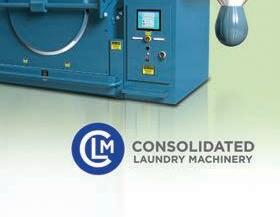

As they perform their job functions, all production is automatically tracked. Productivity calculations are performed in real time and reports can be created with a few mouse clicks. Human error is eliminated, and this tedious task is completed with little to no effort daily, allowing leadership to focus on other pressing issues.
It is to be expected that the second method of tracking will require a much more substantial upfront investment. However, the return on that investment is priceless. The ability to operate daily with a successful productivity program in place will ensure that labor expenses are in line with budgets and that you will hit that all-important cost-perpound figure.
dries put more stock into productivity, whereas a hospitality plant’s focus may lean heavier on quality to maintain customer loyalty. It is a balancing act for each, as they might set the numbers too high and sacrifice quality; however, setting the numbers too low will create a production loss. The owner must look at the equipment capabilities and the staff on hand to determine where they can be within each department.
Within any plant, the proper production standards are essential for a successful operation, and the employees are vital regardless of the level of automation. With

having either a productivity management system or manual entry method, it has to be easily accessible to both the supervisors and operators for everyone to work from the same information.
I have seen success with owners using the data in a format of rewarding the staff for aboveaverage efficiencies, while also using it to train or discipline those who are not helping increase the pounds-per-operator-hour (PPOH) ratio.

On the equipment side, we have installed many successful rail and tunnel systems and have seen tremendous boosts in over-
all washroom efficiencies. The employee plays a key role even with a high level of automation, as they must manage the batch sequencing going into the tunnel to allow a constant flow of linen through the system.
Every equipment vendor will calculate a system based on a mix of full-dry and conditioned items in the dryers; therefore, an appropriate sequencing should be managed during the shift. Sometimes we see some operators send a long run of full-dry items, which eventually causes a dryer bottleneck and cuts down on the potential throughput. An appropriate
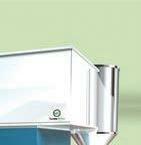

mix of items will allow a more manageable and steady finishing department for the ironer lines and full-dry folding equipment.
Employee input, even in the most-automated rail and tunnel systems, is critical to managing the success of the production within the plant. The good thing is there are many ways to extract data on an hourly, daily, weekly and monthly basis from the automated washroom. The staff can analyze where they can make adjustments and fine-tune to allow better productivity while setting new production standards moving forward. ALN
This is an interesting topic for me, as I am directly related to assisting customers with finding efficiencies by introducing automation technology in the washroom. When visiting with customers, it is essential to find out the production goal, as every laundry is different.
At times, I see healthcare laun-
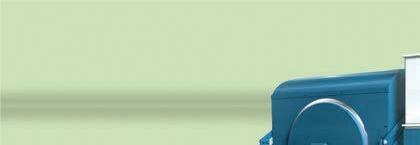
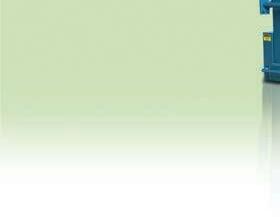
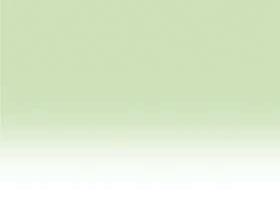
www.AmericanLaundryNews.com AMERICAN LAUNDRY NEWS | NOVEMBER 2017 19 Now “green” comes standard: High e iciency/low emissions burner • Steam-heated, gas fired, 200-1200 lbs. dry weight • Robust engineering—CLM lasts for the long haul • Productivity—lowest drying times • Long history of happy repeat customers • Maintenance—easy to maintain; top notch service support team • E iciency—low utility usage from precise control technology • Wide range—1 door and 2 door pass-through tumble dryers • Customizable design—footprint, controls, tilting and doors For more information call 323-232-2417 or email sales@clmco.com | We want to see you at the Clean Show #3185 | WWW.CLMCO.COM Consolidated Laundry Machinery Dryer Specialists Why buy a dryer from anyone but a company that knows dryers inside and out? Made in the USA New Features! Roll mats with the backing up or down Control the belt automatically or with pedal • Productivity—does the job twice as fast • Safety—designed to reduce operators’ long and short-term injuries • Unique Design—keeps mats from being damaged • Discharge—direct to cart or return to feeder • Stop hand-rolling mats—increase speed and reduce costs For more information call 323-232-2417 or email sales@clmco.com | We want to see you at the Clean Show #3185 | WWW.CLMCO.COM Consolidated Laundry Machinery Mat Roller Experts Why buy a mat roller from anyone but a company known for building “workhorses” that last ? Made in the USA CLM 1-2 island ad ALN.qxp_Layout 1 2/10/17 2:14 PM Page 1 ALN_Jr Page.indd 1 2/13/17 9:36 AM For more information call 323-232-2417 or email sales@clmco.com | WWW.CLMCO.COM For more information call 323-232-2417 or email sales@clmco.com | WWW.CLMCO.COM 8/14/17 2:23 AM Equipment Manufacturing Tony Jackson Kannegiesser ETECH, Grand Prairie, Texas
Rewash: Money down the drain
BY MATT POE, EDITOR
CHICAGO — There’s a dirty word in the laundry and linen service industry: rewash.
“Large rewash volumes waste time and resources from … laundries,” says Mark Moore, vice president of REM Co., a Versailles, Ky.based distributor. “The national
average reject rate is roughly 3% to 5%.”




However, rewash can be reduced by implementing a few process changes and creat-

ing proactive strategies regarding equipment, chemicals, soil types and more. In addition, these strategies can also aid in achieving maximum linen life.
1. LAUNDRY SIZE STRATEGY
Jared Johnson is president and CEO of Dirty Laundry Linen Service in Slidell, La., a specialty laundry that services party rental companies, caterers, wedding and reception venues, event venues and boutique hotels. He says that at Dirty Laundry, the company has production goals to meet, but it is also focused on providing exceptional quality.
One key to raising quality and reducing rewash is to have a solid strategy for quality based on the size of the laundry.
“I have worked in both small and large laundries and now being a partner of a specialty laundry can see some things in larger laundries that make rewash a challenge,” Johnson says. “Large laundries have to be very competitive within the market and have to push out large volumes of laundry to be profitable.
“At the end of the day, you must have a good balance between quality and quantity.”
Sometimes this results in reducing the amounts of certain chemicals used or decreasing the time in the washer, he says. Both will have an effect on the cleanliness of the linens, resulting in increased rewash.
“We are more ‘hands on’ than most laundries and it has paid off for us,” says Johnson.
2. EDUCATE THE CUSTOMER
Many of the tips provided to help reduce rewash involve education. That includes educating the customer about handling linens.
“When we are setting up an account, we will educate on things like not storing linens in a tied-up garbage bag, keeping wet linens separate from the rest, not letting the linen sit too long before getting to the laundry and keeping any stains they notice separate from the rest,” Johnson says.
3. GOOD SORTING
“We

20 NOVEMBER 2017 | AMERICAN LAUNDRY NEWS www.AmericanLaundryNews.com
In the laundry, it’s important to train employees
proper sorting for
on
soil classes.
to inspect the linens as they are being sorted into three categories:
Nine tips to help lower rewash rates, conserve resources, preserve linens
train our soil sorters
light
Our low-fouling Metal Oxide Membrane (MOM) filtration and recycling systems tolerate more organic loading than the leading polymeric membrane and provide quality water at a lower operational cost than any alternative chemical treatment solution. Micro, Ultra, & Nanofiltration Solutions (1 kD- 0.8μm) Recover up to 85% of water and heat Chemical-Free Filtration Process Reduce TSS, BOD, FOG up to 99% Membrane life span > 10 years Designed and Engineered in the USA info@norchemcorp.com 1-800-442-4360 www.NorchemCorp.com Recipient of the NATIONAL POLLUTION PREVENTION ROUNDTABLE MV AWARD Turnkey Waste Water Filtration & Recycling Systems P 30 T HIRTYYEARS OFINNO V A NOIT PERFORMANCEGUARANTEE Don’t Let Your Time Run Out. Start Saving Now. Reducing on average 26 million gallons of effluent per plant per year ALN_Jr Page.indd 1 10/5/17 9:48 AM
(Image licensed by Ingram Publishing)
soil, heavy soil and rewash,” Johnson says. “If all of the linens are sorted into the same cart/sling and washed on the same formula, you are creating more rewash for yourself.”
He says that Dirty Laundry has several formulas set up for different soil classes. The regular wash formula is used for lightly soiled items. The heavy-soil wash formula is used for the heavier-soiled items, and the rewash formula is used for items that are stained or may have mildew on them.
Johnson says that if there is a stain that needs special attention, employees will spot the stain by hand before it is washed.
“The most critical step to take in reducing rewash is pre-sorting like items and soil level,” Moore says. “While a high percentage of facilities are already doing this, it never hurts to remind employees and make sure new employees are well-trained on this.”
4. PROPER LOAD SIZES
Mechanical action plays a huge part in the cleaning process, so that means laundry workers need to be properly trained on load sizes.
“Right size each load,” advises Moore. “Review that staff is wellinformed on just what a full load looks like in the washer.”
Johnson says that if the washer is underloaded, the linen will remain suspended, drastically reducing the mechanical action of the load.
Moore adds, “Underloading will mean too much chemical is being used, which isn’t good for linen life.”
If the washer is overloaded, says Johnson, the linen will not have enough room to move in the wash wheel, reducing the amount of mechanical action necessary to obtain good wash results.
5. APPROPRIATE MACHINES
There is an old adage: “The right tool for the right job.” In a laundry, that means having machines that have the mechanical action and controls needed to wash linens.
“Equip the laundry with machines that feature flexible controls,” Moore says. “Flexible controls—the ability to tailor wash process to the specific soil level and linen type—are quite important. Rewash often is born of a laundry ‘generalist’ mentality, which is all loads get the same wash program.”
Johnson prefers conventional washers over tunnel washers.
“It’s my opinion that conventional washers provide better agitation than tunnel washers,” he says. “In the wash wheel, it’s all about time, temperature, chemistry and mechanical action.”
6. CORRECT WASH PROGRAMS
Soil sorting and load size won’t help laundry quality all that much if correct wash programs aren’t being used on the proper soil and linen types.
Flexible controls on the equipment to shift wash programs is only the start, according to Moore. As with training staff on sorting and
load sizes, managers need to make sure staff is trained on what wash cycles should be used with specific linens and types of soil.
“This is where equipment networked to a laundry manage-






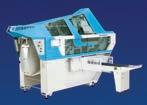




ment system is valuable,” he says. “Managers can review reports to gain a view of what cycles are being selected.”
7. CORRECT UTILITIES



A laundry can have the proper equipment, the correct wash programs, and soil and loads ready to go, but if the laundry’s utilities can’t provide the necessary power, effectiveness is reduced.
That’s why Moore recommends double-checking that the laundry has the right utilities to match the chemicals.
“For instance, chlorine bleach




requires a hot water temperature of 140 degrees (F) to be effective and color-safe bleach requires a temperature of 160 degrees,” he says.
8. CLEANLINESS
Laundry operations can put a lot of time and effort into processing linens properly, but there is still a way they can end up with increased rewash: a dirty plant and dirty carts.
Maintaining a clean plant and carts will help minimize the amount of rewash a laundry experiences.
“You must clean the production area daily to keep the cleanliness of the plant under control,” Johnson
says. “Clean your carts after soiled linen has been transported in them. This will help to reduce incidental rewash as the linen is being moved through the plant.”

9. FINE-TUNE
It takes diligence to maintain equipment and wash formulas in order to produce quality goods and reduce rewash—and save money.
“Work with your equipment distributor and chemical company to fine-tune wash programs and chemical dosing,” Moore says. “Keeping the proper balance is key to delivering excellent results.” ALN

www.AmericanLaundryNews.com AMERICAN LAUNDRY NEWS | NOVEMBER 2017 21
kannegiesser-etech.com 612.722.1366 Kannegiesser USA and ETECH are now Kannegiesser ETECH SMART LAUNDRY seamlessly integrated equipment and systems equipment
you combine two companies, you transform a business. When you combine two leaders, you transform an industry. ALN_Jr Page.indd 1 5/26/17 2:07 PM “... EQUIPMENT NETWORKED TO A LAUNDRY MANAGEMENT SYSTEM IS VALUABLE.”
CO.
When
—MARK MOORE, REM
Effective customer contracts
BY MATT POE, E DITOR
LAS VEGAS — What does a laundry and linen service company want a contract to accomplish?
Steve Fellman, principal in the Washington, D.C., law firm GKG Law, and general counsel for TRSA, the association for the linen, uniform and facility ser-



vices industry, says a contract should accomplish two things: Create a relationship with the customer and have the ability to be enforced in court.
“We want a relationship with our customers that is a meaningful relationship that protects our investment and allows us to perform a service and have a happy customer,” he says. “Also, we need
a document that when it’s presented to a judge, the judge will look at it and say, ‘This is reasonable, this makes sense, and this is something that I feel fair in ruling on behalf of the company.’”
What good is a contract? What should be in a contract? And what makes sense: How can a textile services business sell it to a judge and sell it to the cus-
tomer? Fellman shared some of his expertise on contracts at the Clean Show during a session called Customer Contracts: The Good, The Bad and The Ugly Obviously, a contract is an important document. The customer is agreeing to purchase and install a substantial inventory of uniforms or linens, and the business needs to protect the
investment it has made, Fellman says. In order to properly service the account, the customer needs to fully understand what an operation expects from the customer and what the customer can expect from the operation.
“It needs to be a true meeting of the minds, and it should be written in a document,” he says. “In the worst-case scenario, you need to sue your customer, your contract is the document you’re going to present to the court as a basis for your lawsuit. You have to look at your contract and say is this something my lawyer can present to the court and the judge will say, ‘Yes, that’s a fair, reasonable document.’”
Today, the “document” in question may not be a piece of paper. It may be an online contract that is electronically signed.
“There may be a contract document and they don’t sign it,” says Fellman. “They look at it and they check here that they’ve read this. Did they read it? What’s your experience with online purchases? No one reads it. They just check. Is that legal? In most cases, it is now. But is it enforceable? That brings us to who is the judge, what is that judge going to do?
“All these things are things that you’re going to have to consider and as you move forward, you’re going to have to look at the laws of the various states, what do they say with regards to electronic documents. We’re moving into an electronic age.”
Using contract terms is a way of lessening the customer’s chance to get out of a contract on an unreasonable basis, Fellman says. Clauses he says to consider:
• Notice of breach requirement. That means if the customer feels there’s been a breach, it has to notify the laundry and give a reasonable opportunity to correct.
• Payment for lost goods.
• Buyback or liquidated damages.
• Responsibility. Fellman advises to write into the contract that if there is a catastrophic event, the laundry is not responsible. It’s not responsible for hazardous waste, if the customer provides goods that are soiled with it. Make no representation for flammability of garments.
• Reasonable delivery schedule; make sure that’s defined.
• Pricing and delivery updates.
• Choice of law. Where will the contract be enforced?
• Arbitration, if desired.
• Reasonable automatic renewals vs. evergreens. Evergreen contracts keep renewing. A reasonable automatic renewal, in Fellman’s view, is pref-

22 NOVEMBER 2017 | AMERICAN LAUNDRY NEWS www.AmericanLaundryNews.com
The Most Comprehensive
to Industry Operations Laundry Operations and Management FIRST EDITION $95 members / $150 nonmembers Multiple-copy purchase discounts available 877.770.9274 or 703.519.0029 • info@trsa.org www.trsa.org/store Laundry Operations and Management provides an overview of all aspects of laundry operations: a primer on procedures, technologies and transactions of production, sales and service. It is the only resource that explains how every manager and employee a ects every stage in the laundry process. Nowhere else will you nd as many insights for industry newcomers and veterans alike about industry best practices for processing linens, uniforms and other items. Easy-reading, illustrated 200-page text describes equipment, supplies and techniques for every stage of laundering: Soil Sorting ð Washing ð Drying/Finishing ð Packout ð Delivery Plus an industry history and chapters on maintenance and textiles. Laundry Operations & Management is the o cial text of the TRSA Production Management Institute (PMI). “Individuals new to the business receive a great base to begin their careers. Veterans nd answers to questions that would be very hard to gure out if they didn’t have this resource.” —Tim Radtke, CPLM, Plant Manager, Morgan Services, Chicago ALN_Jr Page.indd 1 10/12/17 11:38 AM
Guide
How does a laundry make contracts that are enforceable, yet make customers happy?
erable because that forces the laundry, eventually, to get a new contract. An evergreen contract, the older it becomes, the more difficult it becomes to enforce. Some states don’t allow evergreen clauses.
• Automatic surcharge for rising costs (but Fellman says a company has to prove that a rise has occurred).
• Reasonable liquidated damages for a five-year contract.
• Standards of service.
Another important factor to consider, according to Fellman, is who is negotiating the agreements? The route salesperson? A professional sales team?
“If you have a program and explain the program to the customer, the customer understands all the things that go into that program,” he says. “Then you have a better chance of letting the customer understand what its responsibilities are and what you’re actually agreeing to do. You’re doing a lot more than providing six sheets every other day.”
Fellman stresses that laundry operators need to keep detailed records. That includes complaints received regarding service and delivery, and how the company responded. Also, note misuse of linens by the customer and the customer’s demand for extras.
“Explain that you’re selling a system, not just a pickup and delivery service,” he says. “Communicate and give the customer an ‘up the command ladder’ option for complaint resolution. And I think the customer is happy if they understand that if they do have a problem, there’s someone they can talk to other than the driver.”
In the end, a contract should help to avoid litigation.

“Litigation is very, very expensive,” Fellman warns. “The only real winners in litigation are the lawyers. Litigation often takes years to resolve and you end up, in today’s world with electronic discovery, you have to turn over all of your computers. It’s something to be avoided at any cost. Even if you arbitrate, it takes time and it takes money.”
The best thing to do is to develop contracts in a form that are reasonable and enforceable, he says. Laundry managers should teach employees how to use contracts for the company’s benefit and avoid cases that involve potential antitrust issues and situations where there’s inducement of breach of contract.
“I think if you follow those steps, you’re way ahead of the game and you have a good basis for protecting your investment,” Fellman says.
Basically, he says a laundry needs to develop a system for identifying problems before the customer becomes so unhappy that it wants to quit. If a legitimate problem surfaces, the company needs to be willing to resolve
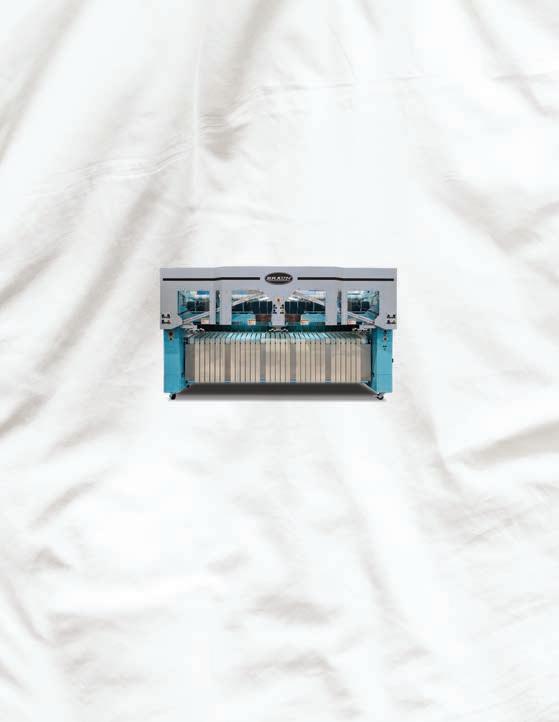
that problem with the customer and make sure other customers don’t have that same problem.
“You want to create a culture where the customers know they can get their concerns addressed promptly and fairly,” Fellman says. “And remember the old saying, ‘An ounce of prevention is worth a pound of cure.’” ALN
This article is for informational purposes only and should not be construed as legal advice. Laundry operators should consult their attorney of choice when creating customer contracts.
www.AmericanLaundryNews.com AMERICAN LAUNDRY NEWS | NOVEMBER 2017 23
PURPOSE BUILT ® BUILT TO SERVICE THE DYNAMIC NEEDS OF THE FLATWORK PROCESSING MARKET. Braun’s new Precision Series® Spreader/Feeder serves a wide variety of flatwork laundry processing needs from hospitality, healthcare, commercial linen providers, and general industrial laundries. Reliability Efficiency Safety Get the Advantage ISO 9001 CERTIFIED Learn more at gabraun.com WHAT’S NEW 1. Single Motor Servo Spread Drive Technology 2. Single Motor Servo Controlled Infeed Functionality 3. Patent Pending Spread Detection Device 4. Spread Carriages with Parallel Clamping Surfaces 5. Balanced Three Operator Station Design 6. Feed Station Clip 7. Single Point Transfer and Positive Center Point Spreading WHAT IT MEANS 1. High Speed Spread Tension Control 2. Provides Consistent Quality Feeding and Leading Edge 3. Automatically Identifies Flatwork Width 4. Exceptional Distribution of Clamping Force and Surface Contact Reduces Sheet Stress 5. Optimizes Space for 3 Operators and Two Carts. Enhances Productivity. Ergonomic. 6. Auto or Manual Function. Drastically Reduces Drops That Clipless Units Experience. 7. Exceptional, Accurate Centering and Quality Feed Results in Consistent Fold Quality of The Finished Product! ALN_Jr Page.indd 1 8/28/17 1:52 PM
(Image licensed by Ingram Publishing)
BY JOHN GOETZ
CINCINNATI — The laundry process has greatly changed over the years, from metal washboards and soap flakes to industrial washing machines and liquid detergents. Because larger facilities like hotels and hospitals run their own laundry programs, the commercial laundry industry has exploded.
Industrial laundries also keep quite busy. On a daily basis, an average-sized laundry plant processes anywhere from 19,000 to 64,000 pounds of laundry, according to TRSA, the association for the linen, uniform and facility services industry. As the volume of laundry processed increases, facility managers take on more responsibility and must utilize innovative technology and equipment, like dispensing systems, to keep up with the demand.
Today’s advancements in sensors, computing power and connectivity are making dispensers smarter and delivering additional benefits
to laundry facilities. Laundries of all sizes now have the tools to improve textile care, enhance safety and reduce their environmental footprint.
It is important for managers to understand what advanced equipment is already available and to stay informed on upcoming capabilities.
THE EVOLUTION OF DISPENSING SYSTEMS
The first chemical dilution system was a simple unit that screwed onto the end of a faucet. Unfortunately, it was easy to tamper with, was negatively affected by water pressure, and allowed chemical back into the water supply, according to Becky Mollenkamp in her article, The Chemistry of ‘Control,’ published in Sanitary Maintenance magazine.
Advances in washing machine and dispensing technology began in the 1970s, improving motor control, enhancing productivity levels and allowing for greater dosing precision. By the 1990s, most machines incorporated microcomputers that
helped control wash times, extract speeds and detergent dispensing, according to Howard Sures, vice president of Esporta Wash Systems.
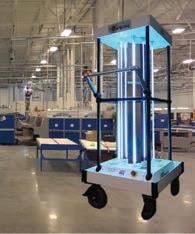
Today, there’s a diverse range of compact and cost-effective systems for a variety of different-sized on-premises laundries (OPL). The best laundry dispensing systems feature technology to simplify the installation process, reduce maintenance and enhance cleaning results. Some examples include low-voltage machine interfaces, pre-wired systems and auto formula select.
Recent developments have even allowed certain systems to provide accurate chemical and water measurements to ensure optimal cleaning results, reduce rewash rates and improve facility productivity.
NEW TECHNOLOGY
The Internet of Things (IoT), a network of connected devices delivering data in real time, has already begun paving a new path for many industries. The number of devices connected to the IoT is expected to grow from the 15.4 billion devices reported in 2015 to 75.4 billion in 2025, according to the white paper, IoT Platforms:
Enabling the Internet of Things, by IHS Markit. Chemical dispensing systems in laundry facilities continue to be part of this trend.
IoT enables facility managers to have remote monitoring and control capabilities, making it possible to keep tabs on chemical dispensing, even when they aren’t on-site. Smart dispensers ensure there is always adequate water supply and that chemical doses are delivered precisely, 100% of the time. They also use safety checks to protect equipment, employees and an entire plant.
For example, if a leak arises, managers will receive an alert from the dispenser and can take immediate action. This prevents the leak from persisting, reducing the risk of damage or needless downtime.
Such dispensers also increasingly utilize sensors to check and monitor information such as the temperature of a load or the flow of chemistry, further tightening integration with the washer.
Laundries generally rely on employees or their chemical provider to make chemical, water or machine adjustments, but this time-consuming responsibility can
now be controlled by dispensers. IoT tracks production processes and handles automated adjustments to dispense chemical based on feedback from an accurate flow meter. This improves cleaning while reducing costs and waste caused by rewash.
Data from sensors provides unique insight into the laundry process, encouraging managers to take a closer look at key performance indicators, like chemical usage by formula, volume of washes and average projection rate. This valuable information allows facilities to identify errors, reduce their recurrence and improve productivity.
THE FUTURE OF LAUNDRY
Connected dispensers already focus on remote monitoring, reducing downtime and delivering important data on chemical consumption, but this is only the beginning. Knowing what to expect and what to look for in new dispensing equipment will give laundries a competitive advantage. Upcoming advancements from chemical dispensing manufacturers include:
• Automated inventory management. Taking inven-









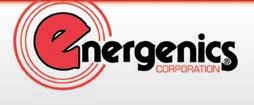
www.energenics.com FOCUS ON CONSISTANT DISINFECTION OF ALL SURFACES ELIMINATING WATER, CHEMICALS & REDUCES LABOR 800-944-1711 MOBILE ULTRAVIOLET BACTERIA REDUCTION 1470 Don St. Naples, FL 34104 • “Laundry Proof-Rugged” • Fully User Programmable • Shatterproof Bulbs • Redundant Safety Features • Fully Portable • Fully Assembled and Tested • Common 120/60/1 voltage • Linen Transport Vehicles • Cafeterias • Restrooms • Surgical Packing Rooms • Offices • Breakrooms • Soiled Sortation Area FEATURES EXAMPLE USES UV-MAX CAN BE USED IN ANY LOCATION WITHIN CLOSED DOORS 0917aln_UV-MAX tab hlf.indd 1 8/4/17 10:07 AM 24 NOVEMBER 2017 | AMERICAN LAUNDRY NEWS www.AmericanLaundryNews.com
of dispensing systems
The future
Technologically connected dispensers are only the beginning, author says
tory is a tedious task that often results in ordering too much or too little product. If dispensers were able to
take on this job, laundries could improve the accuracy of their inventory management. By integrating chemi-
cal usage data into enterprise (ERP), laundry management systems or customer relationship management

(CRM) software packages, dispensers could detect when a certain amount of chemical usage is below a designated threshold and automatically trigger an order for more chemical.
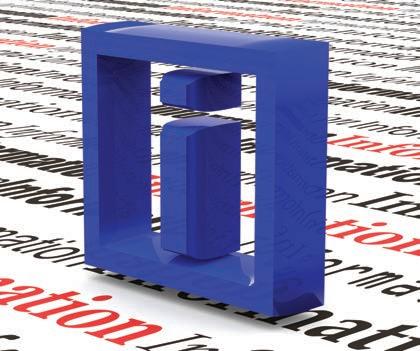
• Predictive maintenance. When a dispenser or washer requires maintenance, it’s not always noticeable. Unplanned maintenance can result in downtime and costly replacements. However, dispensers may one day be able to provide predictive maintenance on downstream equipment by analyzing data and recommending repairs and upkeep before problems arise.
• Load by load data. Advanced dispensers may be able to log data for every wash for compliance purposes and to provide proof of sanitation. Having access to this data, from the weight to the temperature or pH of each load, will help laundries better manage operations and stay organized.
• Data analysis. With more data comes more responsibility, and an abundance of information may intimidate laundry managers. Chemical dispensing manu-
facturers will likely expand their services to include assistance in analyzing and interpreting data. They could also provide laundries with consulting and educational programs to help managers and employees react appropriately when an alarm goes off, and instruct them how to analyze and organize data on their own.
BETTER LAUNDRY FOR A BETTER TOMORROW
Chemical dispensing technology has vastly improved from only a few years ago, allowing the laundry industry to improve and grow. In the near future, additional technological advancements will make the laundry process even simpler, safer and more sustainable.

Smart dispensers are transforming the wash process for the better, providing cleaner laundry for a cleaner future. So, if your facility hasn’t yet installed a smart dispenser, what are you waiting for? ALN
John Goetz is a global product manager with Hydro Systems, an independent manufacturer of chemical injecting, proportioning, dispensing and medicating equipment. He can be reached at jgoetz@hydrosystemsco.com. For more information, visit www.hydrosystemsco.com
OMNI Solutions supercharges your in-house laundry system, providing the LUX Hydroxyl System at no cost. Utilizing a safe, UV light bulb, the LUX Generator turns room air into earth’s strongest natural oxidizer: hydroxyl radicals. 500 times more powerful than hot water and bleach, the system achieves outstanding bright whites, and helps keep linens softer than traditional chemistry.
www.AmericanLaundryNews.com AMERICAN LAUNDRY NEWS | N OVEMBER 2017 25
SOLUTIONS | 700
STREET | BARABOO,
53913 | 888.356.9111 THE BENEFITS OF LUX 55% 85% 5% 20% ALN_Tab_half.indd 1 10/13/17 1:48 PM
System Supercharge OMNI
MOORE
WI
Dispensing systems are becoming more connected, offering more data to laundry operators. (Image licensed by Ingram Publishing)
Mission Linen Supply earns Sustainability Leadership Award
SANTA BARBARA, Calif. — Mission Linen Supply, a provider of linens, uniforms, laundry services and select operating supplies, received a Sustainability Leadership Award in the Business Intelligence Group’s 2017 Sustainability Awards program, the company reports.
These awards honor people, teams and organizations that have made sustainability an integral part of their business practice or overall mission. Mission was recognized for its earth-conscious approach to laundering, processing and distributing linens and uniforms.
As early as 1973, Mission says it installed one of the industry’s first wastewater recycling systems, and to this day the company demonstrates its dedication to sustainability by implementing water reclamation systems, energy-efficient equipment, paperless initiatives, alternative-fuel vehicles and numerous other “green” initiatives.
“Sustainability has been a fundamental part of our business plan since we were founded in 1930, and our commitment to preserving the environment is present in everything we do,” says John Ross, Mission’s president and CEO. “We are honored to have our efforts recognized, and we will always continue to seek new ways to make our operations even more environmentally friendly.”
Mission says its air compressors and pumps feature variable-speed pumps that result in an energy savings of approximately 660,000 kilowatt hours per year, and the company’s energy-efficient lighting systems and upgrades produce an estimated savings of 370,000 kilowatt hours per
year. Meanwhile, Mission’s reclamation and water reuse programs save an estimated 141 million gallons of water per year.

Ecolab Textile Care signs exclusive agreement with OMNI Solutions






ST. PAUL, Minn. — Ecolab Textile Care has signed an exclusive global agreement with OMNI Solutions for its Smart Ultraviolet Light Advanced Oxidation System technology for commercial laundries, the company reports.
Ecolab says the partnership between it and OMNI Solutions offers commercial laundry operators a unique, patent-pending solution for treating reuse water that pro-
vides substantial water and energy savings, enhanced textile quality and improved wash aisle efficiencies.

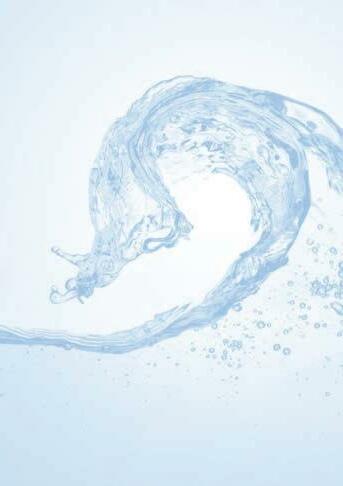
The Smart Ultraviolet Light Advanced Oxidation System works with Ecolab’s AdvaCare™ Disinfectant to deliver the highest standard of clean, according to the company.

“This new ultraviolet light technology offers a revolution in sustainable commercial laundry water and energy management,” says Chris Smith, vice president and general manager, Ecolab Textile Care North and Latin America. “This breakthrough technology, enhanced by Ecolab’s extensive industry expertise, comprehensive solutions and on-site personal service, is producing the highest-quality results, delivering cleaner, safer linens, water and energy savings, and operational efficiencies.”
Engineered for use with tunnel washers, the Smart Ultraviolet Light Advanced Oxidation System dissolves organic materials from the press water, turning previously unusable waste water into clean reuse water and improving tunnel water cleanliness, the company says. This process helps significantly reduce a tunnel washer’s total fresh water and energy consumption.
Ecolab says the initial phases of product testing also have shown significant odor reduction and improved whiteness to linens.
“As the global leader in commercial laundry technologies, Ecolab consistently delivers the very best innovations,” says Andrew Rupnow, founder and chairman of OMNI Solutions. “This exciting and exceptional partnership will provide a relentless force against the most demanding health and sustainability issues, setting a new global standard for commercial laundry processing.”
26 NOVEMBER 2017 | AMERICAN LAUNDRY NEWS www.AmericanLaundryNews.com
. . . . the development of the MAXX Chemical Series focusing on the large laundry market. The combination of products and dispensing equipment in the MAXX Chemical Series produces superior results on every type of soil one may encounter! Let U.N.X. show you how to get the MAXX from your operation! Connect with us! U.N .X. INCORPORATED (252) 756 -8616 www.unxinc .com ALN_Jr_half.indd 1 6/14/17 3:38 PM ALN_3rd Page.indd 1 10/13/17 11:04 AM
Mission Linen Supply says it started its “earth-conscious” approach to business as early as 1973. (Photo: Mission Linen Supply)
Washing Systems acquires Clearbrook for water treatment
LOVELAND, Ohio — Washing Systems LLC (WSI), a provider of products and services to the specialty cleaning and commercial laundry markets, has acquired the assets of Clearbrook Inc., the company reports. Terms of the deal were not disclosed.
Clearbrook is based in Neenah, Wis., and provides water treatment products. The company specializes in consultative-driven processes that drive operational solutions and regulatory compliance, according to WSI.
President and CEO Bill Lahvic and the entire Clearbrook team will join WSI and continue to grow the Clearbrook customer base, the company says.
“We are pleased to be able to expand our resources with the addition of Clearbrook and build upon our growing water treatment business,” says Jon Dill, WSI’s CFO and executive vice president. “The experience and expertise of the Clearbrook team will be a true differentiator as we expand in the water treatment market.”
“We are fortunate to be able to partner with WSI, a company that shares the philosophy of personalized service and individualized care on which we have built our business,” Lahvic says. “We look forward to joining the WSI team and are excited about the opportunity to continue to expand and grow together.”
Edmar Chemical Co., Lonza form strategic alliance
CHAGRIN FALLS, Ohio — Edmar Chemical Co., based here, and Lonza, a Swiss multinational chemicals and biotechnology company headquartered in Basel, have entered into a strategic alliance, Edmar reports.
The purpose of the alliance is to develop and sup-
ply antimicrobial treatments designed specifically for laundry applications. Edmar says these treatments will be tailored to markets providing textile care and finishing in industries such as:
• Industrial laundry
• Healthcare laundry
• Nursing homes
• Athletic facilities
• Correctional facilities
• Colleges and schools
• Food processing plants


• Labs and clean rooms
According to Edmar, Lonza identified the company as the right partner to bring a new generation of products to this market. Edmar says that combining Lonza’s research and design expertise with the company’s market and application knowledge, and its distribution network, will allow for rapid deployment and availability of these new products.
Edmar says that organisms with kill claims include:
• Corynebacterium ammoniagenes
• Enterobacter aerogenes
• Escherichia coli O157:H7 (E. coli O157:H7)
• Klebsiella pneumoniae
• Listeria monocytogenes
• Pseudomonas aeruginosa
• Salmonella enterica (salmonella)
• Staphylococcus aureus—Community Associated Methicillin-Resistant (CA-MRSA) Staphylococcus aureus
• Staphylococcus aureus—Hospital Associated Methicillin resistant (HA-MRSA)
• Staphylococcus aureus (staph)
The products will be available for private-label distribution in North America (U.S., Canada and Mexico) exclusively through Edmar, the company says. ALN

INDEX OF ADVERTISERS

Company Page
A.L. Wilson Chemical Co. 9
ADI American Dawn 5, 17
Consolidated Laundry Machinery 19
Direct Machinery Sales Corp. 28
Energenics 24
G.A. Braun 23
Girbau Industrial 7
The Griffin Group Inc. 28

J.P. Equipment 28
Kannegiesser ETECH 21
Kemco Systems 26
LaundryCareers.com 28
Lavatec Laundry Technology 32
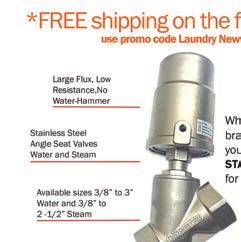
Maytag Commercial Laundry 15
Monarch Brands 10, 11
Norchem Corp. 20
OMNI Solutions 25
Pellerin Milnor 3, 13
PSP Industrial 28

R.W. Martin & Sons 27
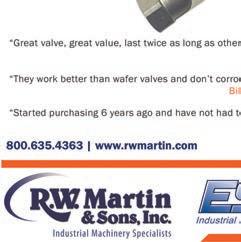
Roadrunner 28
SonicAire 27
Stanco Industries 28
Superior Uniform Group 8 TRSA 22
UNX Chemicals 26 Venus Group 18 Washburn Machinery Inc. 28

www.AmericanLaundryNews.com AMERICAN LAUNDRY NEWS | N OV EM BER 2017 27
For details about the SonicAire fan: 336.712.2437 | moreinfo@SonicAire.com Prevent overhead dust buildup. Maintain OSHA combustible dust regulations. Keep employees safe from dust explosions. One-time investment can pay for itself in a year.
Dust Has Nowhere to Hide. ALN_Jr Half.indd 1 10/11/17 9:55 AM ALN_Jr_half.indd 1 10/3/17 1:44 PM
Fugitive
Classified Advertising







PARTS FOR SALE
PARTS, PARTS, PARTS
Huge stock of parts for most laundry equipment & boilers. Also traps, valves and lubricants. Overnight delivery. Steiner-Atlantic, 800-333-8883 Fax: 305-751-8390 parts@steineratlantic.com www.steineratlantic.com
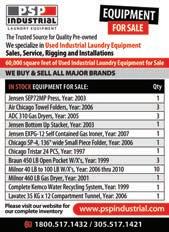
WASHEX PARTS
Hard-to-find Washex parts, on-site rebuilding, tech support. LAUNDRY PARTS CENTER 800-352-4492 Fax: 305-827-3991

LEAD SERVICE TECHNICIAN / ENGINEER


Industrial laundry equipment distributor in the Chicagoland area seeks a Lead Service Technician / Engineer. We are willing to relocate the right candidate. Our busy service department is in need of a lead technician with 3-5 years’ experience in the industrial laundry industry.

Qualifications:

• CBW experience
• Strong electrical/mechanical background
• Able to read wiring diagrams

• Able to use Multimeter


• Ability to troubleshoot
• Professional demeanor
• Able to lift 50-100 lbs. Please email resume to resumes8778@gmail.com

Starr Textile Services
Is seeking to fill a Chief Engineer Position in New Orleans, LA. Applicants need to have at least five years of experience in management, strong troubleshooting skills in electrical, hydraulics, pneumatics, steam, and general mechanics. Experience with Milnor and Chicago equipment a plus. Responsibilities to include leading a six man maintenance staff and two janitorial staff for a seven day a week facility. Excellent compensation and benefits packages. Please email resume and cover letter to CDavis@StarrTextileServices.com

28 NOVEMBER 2017 | AMERICAN LAUNDRY NEWS www.AmericanLaundryNews.com
POSITIONS AVAILABLE
®
The Griffin Group, Inc. “Recruitment Specialist” Need to FILL a position? Call Deana Griffin 888-235-2365 www.thegriffingroup.cc deana@thegriffingroup.cc
EQUIPMENT FOR SALE NEW FOLDERS & SELF CONTAINED IRONERS 68” - 138” Wide WWW.JBILAUNDRYFOLDER.COM AMKO AMERICA INC. Parts, Supplies, Service Remanufactured Finishing Equipment AmkoAmerica@gmail.com 561-863-9696 DISTRIBUTOR OFFERINGS POSITIONS AVAILABLE USED CARTS WANTED Call Craig Lloyd toll free at 877.295.5693 between 9 a.m. – 9 p.m. EST. Please visit www.laundrycareers.com to review current industrial/institutional laundry management openings. ADVANCE YOUR CAREER U.N.X. INCORPORATED“ ” grow & expand U.N.X.! U.N.X. INCORPORATED DESCRIPTION FOR NEW OR USED LAUNDRY EQUIPMENT, DM IS YOUR SOURCE FOR ALL YOUR NEEDS Milnor 72072 500lb Gas Pass-Through System Dryers (2006) (2) Challenge Reconditioned Pacesetter Gas Dryers (1) Kemco (2) Stainless Steel Storage Tank 1500 gallon and Two Pass Heat Reclaimer Pik-Quik Sheet Sorter (1) Milnor 140lb & 100lb Solid Mount Washers (2001) Braun Return to Feed SPF Chicago Skyline 4-lane with stacker (2006) Skyline Mini (2009) with Stacker Jensen Reconditioned 2-Roll 36 Steam Ironer Chicago Edge Spreader Feeder (2001) Wascomat 55lb Soft Mount Washer Colmac CFS 90 Steam Tunnel (2006) UNIPRESS CRD Rotary Double Buck For Pricing call Ron Hirsch 516.938.4300 • 516.315.7426 Hicksville, NY • www.directmachinery.com Stanco Industries, Inc. Serving The Textile Trades Since 1970 800-932-3769 k for Mike or Deb KEEPING IT GREEN SINCE 1970 WE ARE LOOKING FOR THE FOLLOWING EQUIPMENT: WASHING • DRYING • FOLDING FEEDING • IRONING • FINISHING MATERIAL HANDLING • BOILERS CONTINUOUS BATCH WASHING STACKERS • CART DUMPERS DON’T BE LEFT WITHOUT POWER Emergency Generators Available 50KW to 1000KW Natural Gas & Diesel Please visit our updated website: www.stancoind.com E-mail: buyer@stancoind.com 2014 Chicago 232 Imperial 120” Gas Ironer 2013 Chicago 48 Imperial 120” Gas Ironer 2006 Chicago Tristar 32 PCS 120” Steam Ironer/Folder/Stacker 2009 Chicago Tristar 28 PCS 120” Gas Ironer With Spreader/Feeder 1997 Chicago Tristar 24 PCS 120” Gas Ironer 2004 Chicago Skyline S-13 Cross Folder With Stacker & Conveyor 2011 Chicago “Air Express Chicago” Small Piece Folder 2009 Chicago Skyline Blanket Folder W/Chi Touch & Triple Fold 2007 Weir Vacuum Feeder 120” 2013 Weir Triple Sort Towel Folder 2013 Cissell 75LB Soft Mount Washer 2010 Milnor 60LB Washers (Qty. 2) 2013 Milnor 75LB Steam Dryer 2007 UniMac 75LB Gas Dryer View photos of entire inventory at www.washburnmachinery.com 800-245-8425 Keepin’ it clean for over 65 years! WANTED USED LINEN / LAUNDRY BULK CARTS roadrunnerwm.com/equipment 412.430.0037 RoadRunner Recycling wants to purchase used linen/laundry bulk carts on wheels with cut out fronts. Approximate Size : L x W: 48ʺ x 28½" and Height: 66" 2003 Chicago Skyline Mini 2003 Chicago King Edge w/Vac 1993 Chicago 48” Ironer 2009 Chicago Skyline 4-Lane (2) (2006/2007) 140lb Milnor W/E 2005 130lb Milnor Conway (2) 450lb Lavatec Dryers We have a huge inventory of BRAUN PARTS - visit out parts page or call 800/925-3236 if you don’t see what you are looking for. Equipment is priced to sell! www.ineedjpequipment.com www.ineedjpequipment.com “Expect Excellence”
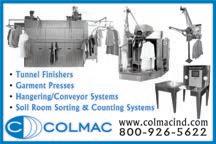










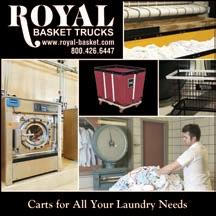

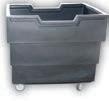










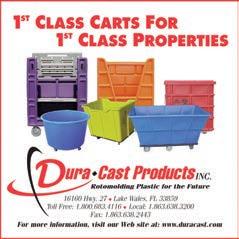
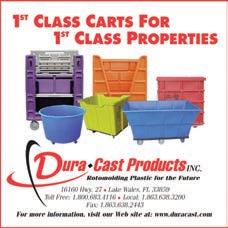






















www.AmericanLaundryNews.com AMERICAN LAUNDRY NEWS | NOVEMBER 2017 29 Source Directory A convenient guide to sources of products and services APPAREL FINISHING CARTS, TRUCKS & BASKETS Source Directory listings in American Laundry News are sold on an annual basis at the following rates: All Major Credit Cards Accepted 2017 Listings Regular Boldface All Caps Four Line Listing per Year $890 $1,115 $1,115 Display and additional line rates available upon request CARTS, TRUCKS & BASKETS CARTS, TRUCKS & BASKETS ● Folder Stackers ● Tunnel Finishers ● Cart Washers ● Pressing Equipment ph: 704.483.9316 sales@leonardautomatics.com http://leonardautomatics.com leonardautomatics.com/t-shirt_c Free T-Shirt Financing Available Laundry/Bushel Trucks • Exchange/Flare/Security Carts • Spring Lifts Diversified Plastics, Inc. South Carolina & Georgia • 800.768.7636 sales@dpirotocarts.com • dpirotocarts.com On-Time Delivery & Quality Service! BEST LAUNDRY TRUCKS & CARTS BEST LAUNDRY TRUCKS & CARTS M c C LURE INDUSTRIES, INC. Sani-Trux is the only molded cart to pass rigorous independent laboratory testing for NFPA fire codes Made of durable fiberglass making the cart life at least twice that of a poly cart Easy to maneuver even in tight spaces Built with quality components to last years longer than other carts Visit our website for other models and avaliable options. We sell direct to all parties! WWW.MITPOLYCART.COM For more information, visit our Web site at: www.duracast.com Please call and reference promotion #17ALN to receive your special freight rate. ll -800-275-2436 -800-275-2436 maxi-movers.com Email:sales@maxi-movers.com Heavy duty polyethylene easy access tables. 50”W x 98”L x 35”H Ergonomic height reduces bending and reaching. MAXI SORTING TABLE Features powder coated steel frame and easy rolling 6” x 2” rubber, non-marking casters. Two braking casters. Chm #9805 ALN Sorting Table:Layout 1 8/3/16 10:25 NEVER LOSE ANOTHER SHELF Call 800.829.4535|questions@MODROTO.com | MODRoto.com We Put More Into Our Carts So You Can, Too! shelves. No more shelf matching, no more lost shelves. See action video at MODRoto.com and call for free quote. clean to soiled in seconds without removing the americanlaundrynews www. .com
































30 NOVEMBER 2017 | AMERICAN LAUNDRY NEWS www.AmericanLaundryNews.com Source Directory A convenient guide to sources of products and services FLATWORK IRONERS FLATWORK IRONERS Knowhow In Action Your Tingue rep is a fully trained master of finishing equipment operation, maintenance and installation. Call for: • Pads, covers, belts, waxes, tapes and more • Carts, trucks, baskets and bags • Parts, rebuilds and repairs 800.829.3864 www.Tingue.com MODRoto.com TBR-Associates.com C & W EQUIPMENT (800) 443-3573 FLATWORK IRONER SPECIALISTS REMANUFACTURED IRONERS: Super Sylon Sylon Hypro’s Super Pro Jensen SS700 SS800 Ultima Lavatec UPGRADE KITS: Chain Drive Conversion Vacuum Systems Herringbone Conversion Canopies Inverters Side Covers Roll Springs Jensen Drives SUPPLIES: Aprons Pads Covers Belts Waxes Cleaners PARTS/REPAIRS: All Brands New/Refurbished/Hard to Find COMMITTED TO EXCELLENCE Your friendly Rep can help with: • Pads, Covers, Wax Cloths, Cleaning Supplies • Rebuilding your ironer • Parts, Sales, Service, Rigging (602) 253-9687 • www.azsle.com The Flatwork Ironer Specialists Pellerin Milnor Corp. P.O. Box 400, Kenner, LA 70063 504-467-9591, Fax: 504-468-3094 www.milnor.com DRYERS – 100 POUNDS OR MORE Pellerin Milnor Corp. P.O. Box 400, Kenner, LA 70063 504-467-9591, Fax: 504-468-3094 www.milnor.com CLEAN CYCLE SYSTEMS 960 Crossroads Blvd., Seguin, TX, 78155 800-826-1245 • CCsystems@tqind.com www.cleancyclesystems.com DRYERS – 100 POUNDS OR LESS LINT COLLECTORS & FILTERS MAT ROLLERS DRYER BOOSTER & EXHAUST FANS www.energenics.com ENERGENICS CORPORATION TALK TO OUR DESIGN AND ENGINEERING STAFF ABOUT YOUR NEEDS 1470 Don St. • Naples, FL 34104 • 800-944-1711 ›› Our In-Line Lint Filter mounts inside, saves space! ›› OPL Duct Mounted Lint Filters 1,000 to 2,700 CFM ›› Fiberglass or Stainless Steel Dry Filters ›› Hundreds Sold Annually Source Directory listings in American Laundry News are sold on an annual basis at the following rates: All Major Credit Cards Accepted 2017 Listings Regular Boldface All Caps Four Line Listing per Year $890 $1,115 $1,115 Display and additional line rates available upon request HEALTH CARE LINEN TRANSPORT CARTS “In-House” or “Over-The-Road Transport” Ergonomic Aluminum - Tough Fiberglass – Ultimate Stainless ALL SIZES & CUSTOM C APABILITIES 800-826-1245 | www.tqind.com | TQcarts@TQind.com America’s #1 Trusted Source Since 1961! HEALTHCARE LINEN TRANSPORTS CART-WASHING SYSTEMS www.energenics.com ENERGENICS KARTWASHERS FULLY AUTOMATIC KARTWASHER PREMIER W/TOUCHPAD 1470 Don St. • Naples, FL 34104 • 800-944-1711 Designed to wash and sanitize all popular laundry carts • Automatic two minute cycle • Dries and sanitizes • Minimum water useage Concentrates wash effectiveness on the cart interior Fast automatic washing, sanitizing and drying insure optimum cleaning • 15 second detergent wash and sanitizing rinse cycle • Adjustable automotive car wash style drying 1116aln_Energenics Cart Washers SD.indd 1 9/27/16 3:30 PM What Every Laundry Needs In A Cart Washer: M c C LURE INDUSTRIES, INC email: kim@mcclureindustries.com 800-752-2821 • www.mcclureindustries.com A cart washer that works continuously for 15-20 years. The ability to install your cart washer in a cross-contamination barrier wall. A cart washer that really, truly cleans each cart of bio-contaminents inside and out. One that uses existing utilities no remodel costs. Time selectable efficient cycles that use a minimum amount of water. FEEDER AND FOLDER BELTS www.superiorbands.com 1-800-227-2906 Sales@superiorbands.com Feeder/Folder Belts Superior Bands, Inc. Buy Direct OPL-Series DLF-500 Lint Lasso 1,000-10,000 CFM Established: 1991 4,000-35,000 CFM Established: 1985 4” to 18” Duct Established: 2011 www.cleancyclesystems.com • 800 . 992 . 0697
Gardner Machinery Corporation P.O. Box 33818, Charlotte, NC 28233 Ph.: (704)372-3890; Fax: (704)342-0758 www.gardnermachinery.com



PRESSES – EXTRACTION
Pellerin Milnor Corp.
P.O. Box 400, Kenner, LA 70063 504-467-9591, Fax: 504-468-3094 www.milnor.com
SMALL-PIECE FOLDERS
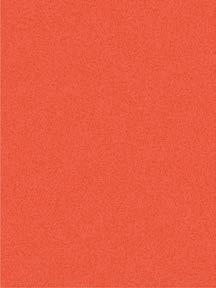
Pellerin Milnor Corp.
P.O. Box 400, Kenner, LA 70063 504-467-9591, Fax: 504-468-3094 www.milnor.com
Pellerin Milnor Corp.
P.O. Box 400, Kenner, LA 70063 504-467-9591, Fax: 504-468-3094 www.milnor.com
Pellerin Milnor Corp.




P.O. Box 400, Kenner, LA 70063 504-467-9591, Fax: 504-468-3094 www.milnor.com

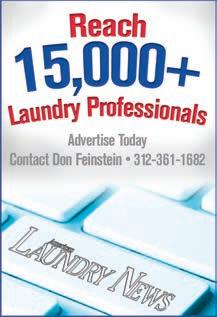




STATEMENT OF OWNERSHIP, MANAGEMENT, AND CIRCULATION
Chicago, IL 60661-1410 Cook County. Editor: Matt Poe, American Trade Magazines LLC, 566 West Lake St., Suite 420, Chicago, IL 60661-1410 Cook County. Managing Editor: Bruce Beggs, American Trade Magazines LLC, 566 West Lake St., Suite 420, Chicago, IL 60661-1410 Cook County. 10. Owner: American Trade Magazines LLC, 566 West Lake St., Suite 420, Chicago, IL 60661-1410 Cook County. Charles Thompson, American Trade Magazines LLC, 566 West Lake St., Suite 420, Chicago, IL 60661-1410 Cook County. Bruce Beggs, American Trade Magazines LLC, 566 West Lake St., Suite 420, Chicago, IL 60661-1410 Cook County. Donald Feinstein, American Trade Magazines LLC, 566 West Lake St., Suite 420, Chicago, IL 60661-1410 Cook County. Nathan Frerichs, American Trade Magazines LLC, 566 West Lake St., Suite 420, Chicago, IL 60661-1410 Cook County. Suhler Family Investment Office LLC, 200 Long Neck Point Rd., Darien, CT 06820 Fairfield County. 13. Publication Title: AMERICAN LAUNDRY NEWS. 14. Issue Date for Circulation Data Below: September 2017 15. Extent and Nature of circulation: (average number of copies each issue during proceeding 12 months=”X”) (Number copies of single issue published nearest to filing date = Y”) (a) Total Number of Copies (Net press run): X=15,405, Y=15,445. b. Legitimate Paid and/or Requested Distribution (By Mail and Outside the Mail). (1) Outside County Paid/Requested Mail Subscriptions stated on PS Form 3541. (Include direct written request from recipient, telemarketing and Internet requests from recipient, paid subscriptions including nominal rate subscriptions, employer requests, advertiser’s proof copies, and exchange copies.) X= 9,707, Y=9,719. (2) In-County Paid/Requested Mail
Subscriptions stated on PS Form 3541. (Include direct written request from recipient, telemarketing and Internet requests from recipient, paid subscriptions including nominal rate subscriptions, employer requests, advertiser’s proof copies, and exchange copies.) X=0, Y=0. (3) Sales Through Dealers and Carriers, Street Vendors, Counter Sales, and Other Paid or Requested Distribution Outside USPS®: X=0, Y=0. (4) Requested Copies Distributed by Other Mail Classes Through the USPS (e.g. First-Class Mail®): X=0, Y=0. (c) Total Paid and/or Requested Circulation (Sum of 15b (1), (2), (3), and (4)): X=9,707, Y=9,719. (d) Nonrequested Distribution (By Mail and Outside the Mail). (1) Outside County Nonrequested Copies Stated on PS Form 3541 (include Sample copies, Requests Over 3 years old, Requests induced by a Premium, Bulk Sales and Requests including Association Requests, Names obtained from Business Directories, Lists, and other sources): X=5,487, Y=5,474. (2) In-County Nonrequested Copies Stated on PS Form 3541 (include Sample copies, Requests Over 3 years old, Requests induced by a Premium, Bulk Sales and Requests including Association Requests, Names obtained from Business Directories, Lists, and other sources): X=0, Y=0. (3) Nonrequested Copies Distributed Through the USPS by Other Classes of Mail (e.g. First-Class Mail, Nonrequestor Copies mailed in excess of 10% Limit mailed at Standard Mail® or Package Services Rates): X=0, Y=0. (4) Nonrequested Copies Distributed Outside the Mail (Include Pickup Stands, Trade Shows, Showrooms and Other Sources): X=58, Y=100. (e) Total Nonrequested Distribution (Sum of 15d (1), (2), (3) and (4)): X=5,546, Y=5,574. (f) Total Distribution (Sum of 15c and e): X=15,253, Y=15,293. (g) Copies not Distributed (See Instructions to Publishers #4, (page #3)): X=152, Y=152. (h) Total (Sum of 15f and g): X=15,405, Y=15,445. (i) Percent Paid and/or Requested Circulation (15c divided by f times 100): X=66.64%, Y=63.55%. 16. Publication of Statement of Ownership for a Requester Publication is required and will be printed in the November 2017 issue of this publication. 17. Signature and Title of Editor, Publisher, Business Manager, or Owner: I certify that all information furnished on this form is true and complete. I understand that anyone who furnishes false or misleading information on this form or who omits material or information requested on the form may be subject to criminal sanctions (including fines and imprisonment) and/or civil sanctions (including civil penalties): Charles Thompson, Date 9/18/2017
www.AmericanLaundryNews.com AMERICAN LAUNDRY NEWS | N OV EM BER 2017 31 Source Directory A convenient guide to sources of products and services PARTS PARTS PARTS & SUPPLIES • Door Handles • Door Locks • Print Boards • Bearing Kits • Drain Valves • Shocks • Heating Elements • Inlet Valves and more! QUALITY LAUNDRY PARTS, GREAT PRICES For questions and custom orders email info@FrontecStore.com (941)726-0808 Handles • Drain Valves • Shocks • Heating Elements • Inlet Valves and more! questions and custom ordersFrontecStore.com (941)726-0808 CINCINNATI LAUNDRY EQUIPMENT We stock all the parts you need! We have something for everybody! Parts for All Major Manufacturers 2648 Spring Grove Avenue Cincinnati, OH 45214 Phone: 513-542-5000 • Fax: 513-542-5022 www.cincinnatilaundry.com cle@cincinnatilaundry.com Your #1 AJAX Source! AJAX • CISSELL LAVATEC • ALLIANCE IPSO • HUEBSCH JENSEN HYPRO/SUPER SYLON HOFFMAN • VOSS PERMAC
– 100
– 100
WASHERS – CONTINUOUS BATCH WASHER-EXTRACTOR
POUNDS OR LESS WASHER-EXTRACTOR
POUNDS OR MORE
MATERIAL HANDLING / CONVEYORS Source Directory listings in American Laundry News are sold on an annual basis at the following rates: All Major Credit Cards Accepted 2017 Listings RegularBoldface All Caps Four Line Listing per Year $890 $1,115 $1,115 Display and additional line rates available upon request 1. Publication Title: AMERICAN LAUNDRY NEWS. 2. Publication Number: 1091-9201. 3. Filing Date: 9/18/17. 4. Issue Frequency: Monthly. 5. Number of Issues Published Annually: 12. 6. Annual Subscription Price: $46.00. 7. Complete Mailing Address of Known Office of Publication: American Trade Magazines LLC, 566 West Lake St., Suite 420, Chicago, IL 60661-1410 Cook County. Contact Person: Charles Thompson, 312-361-1700. 8. Complete Mailing Address of Headquarters or General Business Office of Publisher: American Trade Magazines LLC, 566 West Lake St., Suite 420, Chicago, IL 60661-1410 Cook County. 9. Full Names and Complete Mailing Addresses of Publisher, Editor, and Managing Editor: Publisher: Charles Thompson, American Trade Magazines LLC, 566 West Lake St., Suite
420,





















































































































































































































































































